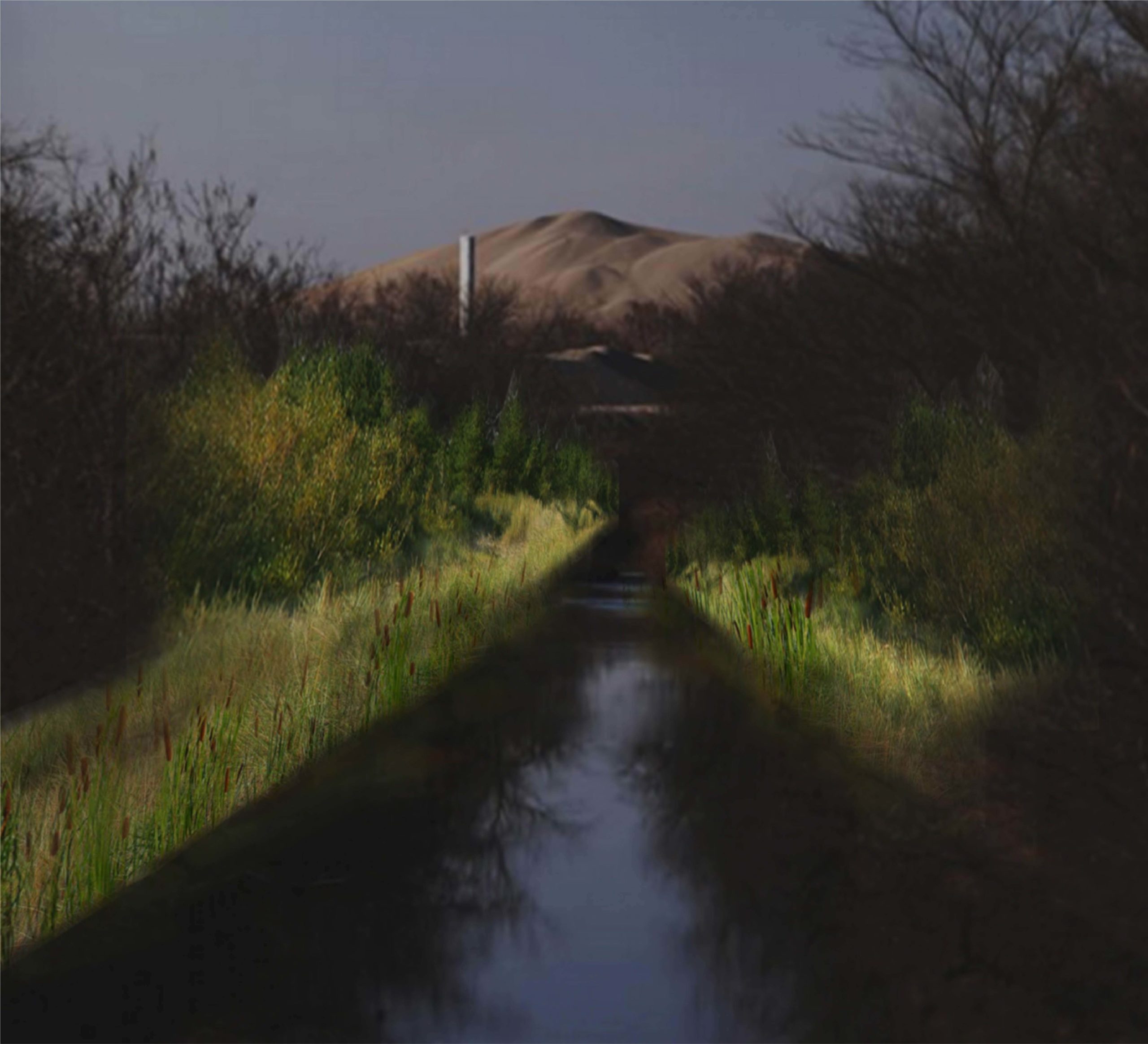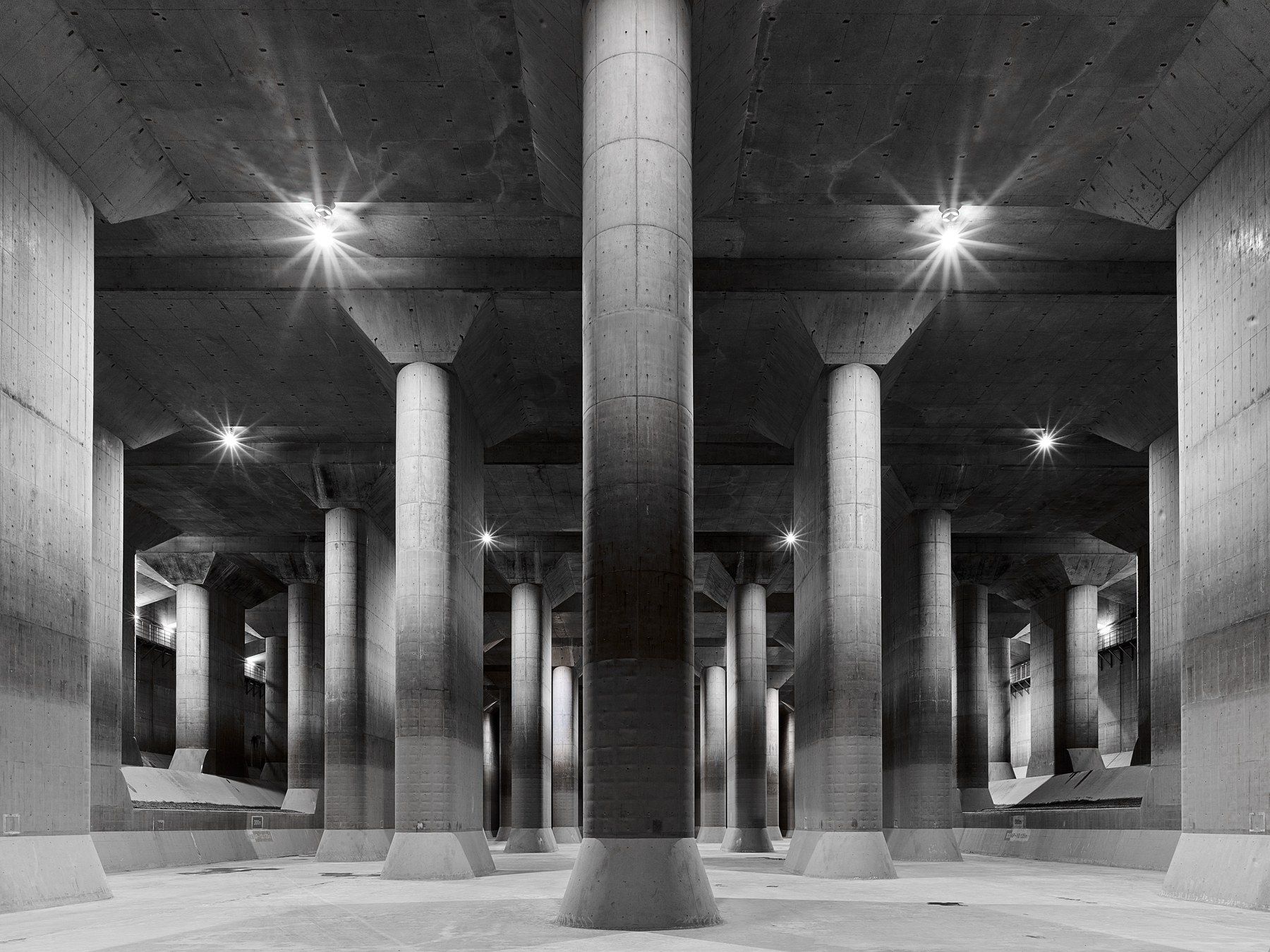John Rahaim on the California Housing Crisis: What are planners to do?
In the past decade, San Francisco has become the poster child for income inequality, housing costs, and homelessness. The regional growth that fueled this national attention has been caused by a perfect storm of two factors: renewed interest in urban living combined with the explosive growth of technology companies. This has led to a worsening condition of economic inequality largely along racial lines. While the same phenomenon is also occurring in other coastal cities, the exorbitant cost of housing in the Bay Area has made the situation more acute. As a planner, urban designer, and former Planning Director for the City of San Francisco from 2008–2020, I was a key player in managing dramatic changes to the city, which saw the most growth in nearly a century during my tenure. It seems clear that in the Bay Area, the price of housing and the associated repercussions are both a cause of, and an almost direct result of, economic inequality and homelessness.In America, housing is a commodity to be bought and sold like a car. The result is that those with means have a place to live, and those without means do not. We must change this paradigm.
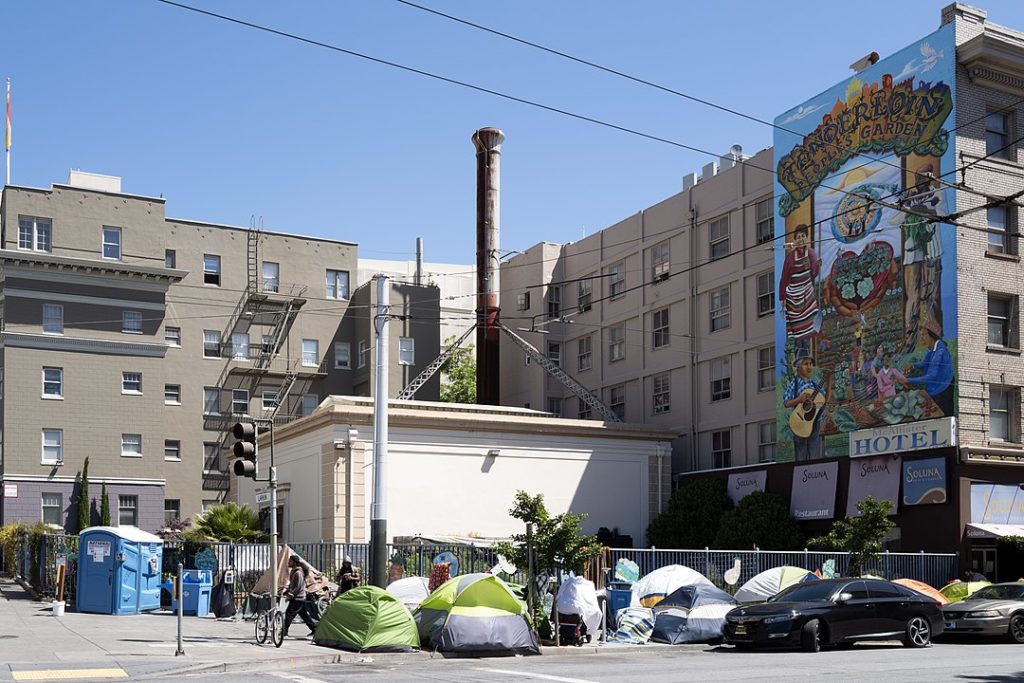
An encampment in San Francisco, 2020. Image by Christopher Michel from San Francisco, USA – Memorial Day 2020 – San Francisco Under Quarantine, CC BY 2.0.
Tar Creek Remade: Taking on 120 years of environmental injustice at an Oklahoma Superfund site
Envision a broad expanse of barren gray mounds riven with erosion channels. Pools of viridian, ochre, and bright russet water fill low areas between the piles. Some of these drain into a meandering multicolored creek that makes its way through rank grass and shrubs. A hot breeze lifts gritty dust from the mounds and swirls it across empty roadways. Its dull dry odor mixes with the sharp acidic tang of the creek. A trickle of water and the whisper of rushing air fill the quiet. Residential streets among the huge piles slowly narrow under encroaching weeds, and cracked concrete slabs hold back overgrown lawns. Only memories of the houses remain along 5th, 6th, and 7th, along Cherokee, Oneida, and Ottawa, and along Treece, Picher, and Main Streets. At Memorial Park a black gorilla on a red pedestal announces a 1984 football victory—Oklahoma division 1A. A block away, rising higher than the gray gravel piles called “chat,” a water tower announces: “PICHER Gorillas since 1918.” From an airplane or satellite, Picher, Oklahoma, appears as an anomaly in the endless green grid of agricultural land at the center of the United States. Huge irregular gray blots and dark pools interrupt the geometric precision of roads, and the colorful smear of Tar Creek runs diagonally through the town. Abandoned a decade ago—like its neighbors Cardin and Douthat, Oklahoma, and Treece, Kansas—Picher reveals a legacy of environmental indifference and staggering injustice.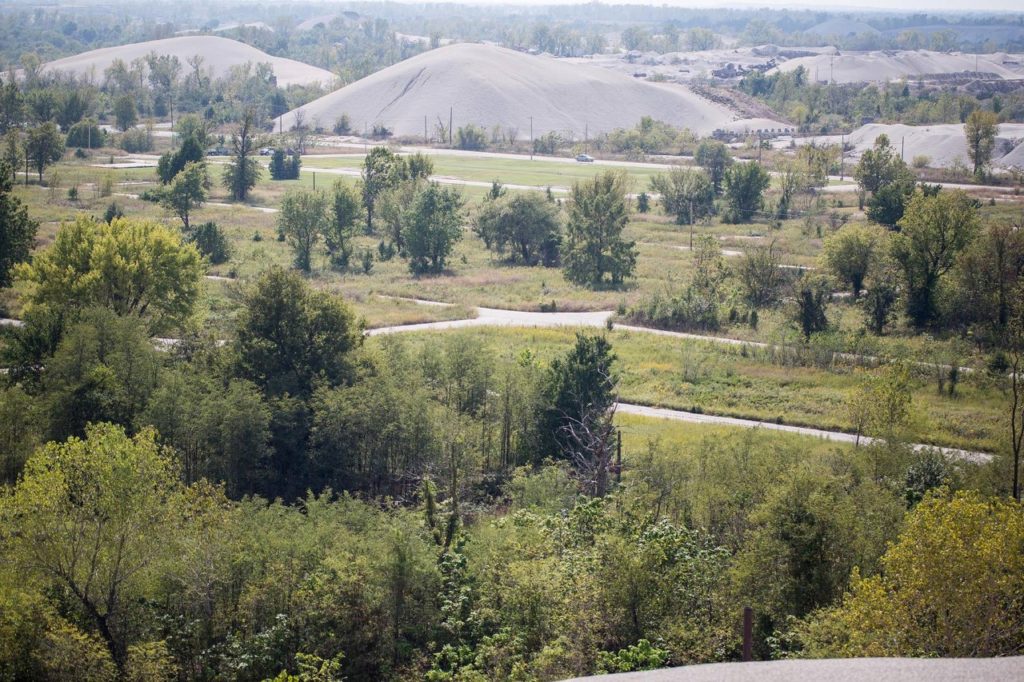
LEAD Agency Inc, Miami, OK and Ed Keahley

LEAD Agency Inc, Miami, OK and Ed Keahley
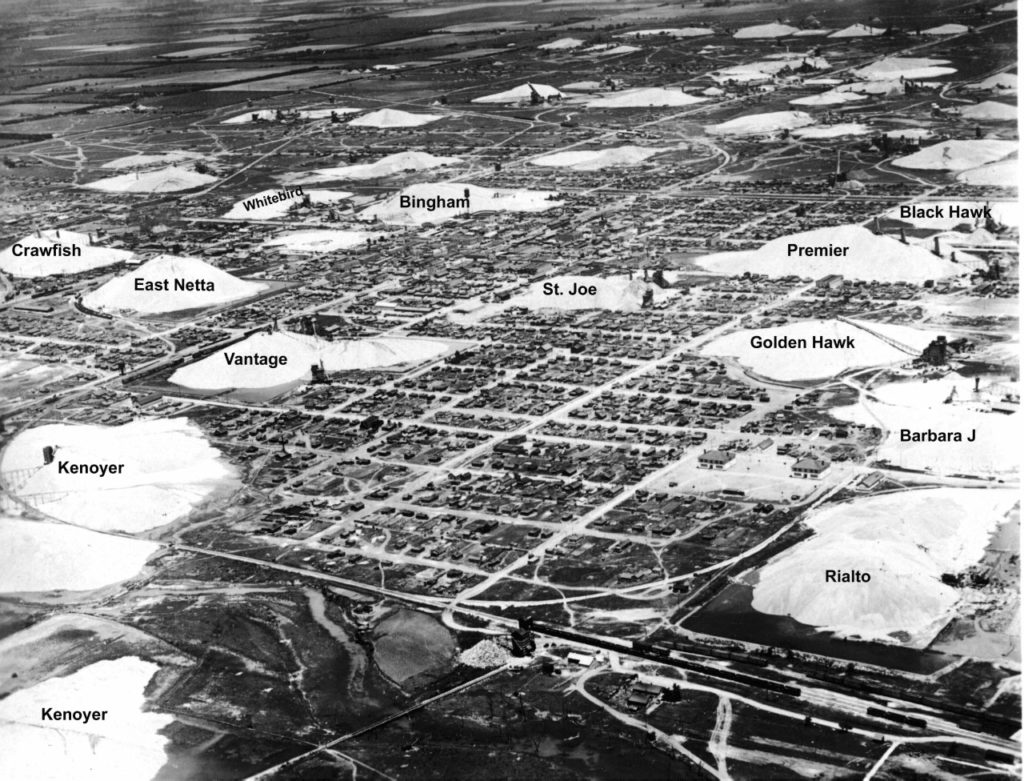
LEAD Agency Inc, Miami, OK and Ed Keahley
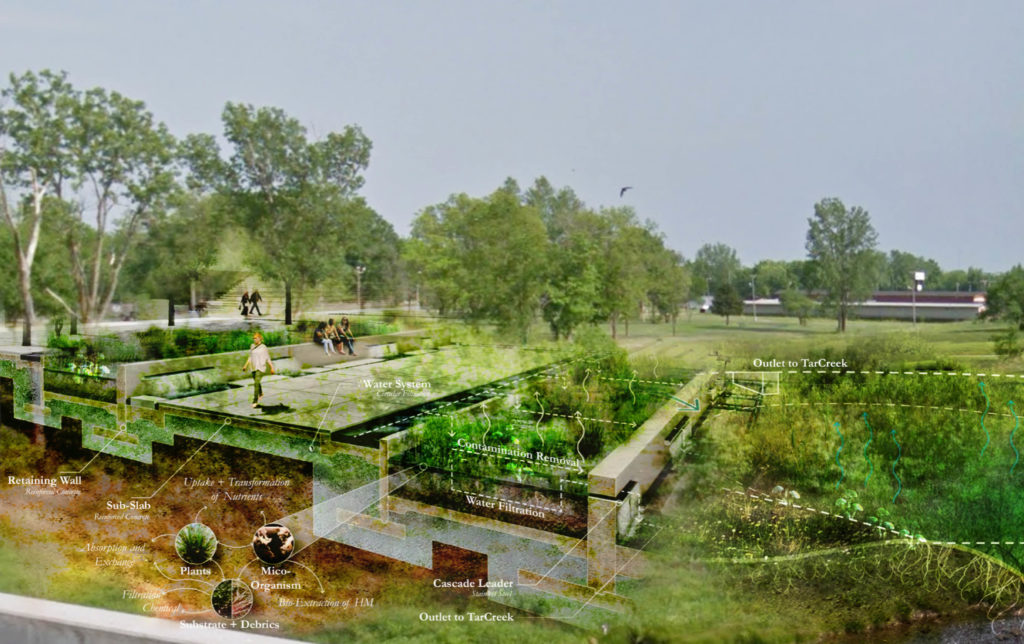
Diagram from Hao Holly Wang’s (MLA ’21) project for the option studio “TAR CREEK REMADE”
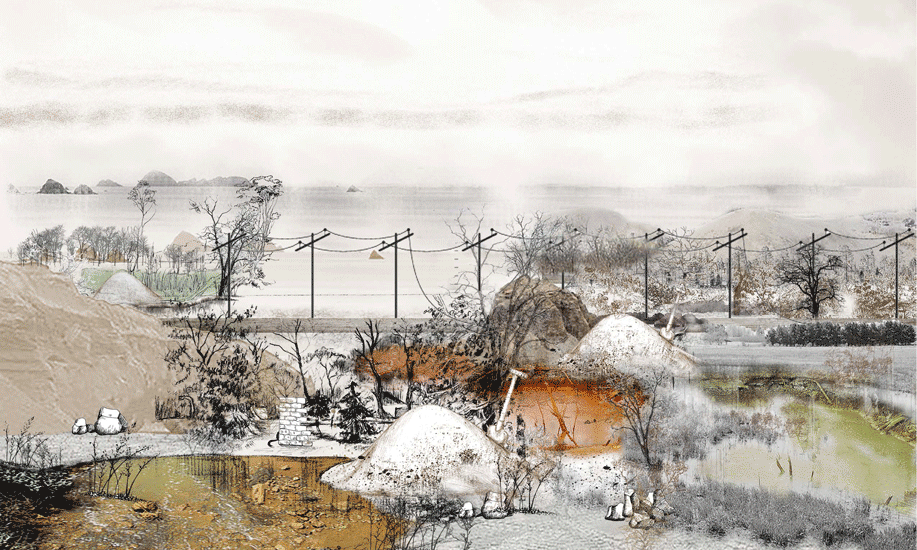
Animation from Jinying Zhang’s (MLA ’21) project for the option studio “TAR CREEK REMADE”
Concluding an Unforgettable Year: A Message from Dean Whiting
Dear GSD Community, As we gathered virtually to watch the Class of 2021 receive their graduation honors, I was overwhelmed with admiration for what you each, and we collectively, managed to accomplish this year. While now is a moment for celebration, it is also a time to reflect, given the impact the past fifteen months and more have had on all of our lives. We all know—we all have lived through—how difficult that time has been. To celebrate and honor you each is also to remind ourselves what work and values we must continue to carry forward. I am always struck by the sheer talent and passion that thrives within our community. One aspect of this year I will never forget is how our students and faculty spoke out, compellingly and evocatively, about the challenges and legacies of racism in our world and in the design fields. I am beyond grateful for our faculty and students who have made race and equity not afterthoughts but core values. We must maintain that ethos. Some important projects on race, equity, and design emerged over the past year at the GSD, illustrating design’s agency to affect these big, structural questions. I want to highlight our African American Design Nexus (AADN) and the podcast it launched this year, “The Nexus,” as well as a specific project that emerged from it: the Harlem StoryMap, created by Thandi Nyambose (MUP ’21). Thandi’s engaging reveal of the designers and stories that shaped Harlem exemplifies both the self-scrutiny and reassessment we must undertake as designers, as well as the overdue honor we owe to those designers whose contributions have long been overlooked. I also want to applaud Toni L. Griffin for launching the inaugural Mayors’ Institute on City Design Just City Mayoral Fellowship, which convened seven Black mayors from around the United States to directly tackle racial injustices in each of their cities through planning and design interventions. These are exactly the sorts of projects that remind us all how much work we have to do, but also how dialogue and action can shift when design intervenes. The pandemic presented us with other challenges, both immediate and ongoing. We needed to create a virtual pedagogy that would be potent and inspiring, and our Innovation Task Force, and really our entire community, worked to develop the finest virtual education possible. I applaud the ITF for their insights, which directly shaped our academic year and will inform and elevate our pedagogy well beyond the pandemic. Introducing “GSD Now” to the community was a real thrill; to be able to gather, if virtually, in shared “Trays” and to immerse ourselves in the daily pulse of activity made our spring semester just a bit more normal. Our Fabrication Lab raised the bar, too, with their Virtual Gund. Our faculty and students deserve a hearty round of applause for pivoting so quickly and effectively and for producing such remarkable work despite great challenge. But we also face broader questions of how people will design and create space in a world where space and coexistence can be feared as dangers. Among those who have begun exploring that bigger question is Farshid Moussavi, who led a fascinating studio last fall on rethinking residential architecture in light of the pandemic and its erosion of the live-work dichotomy. Farshid is among the GSD faculty who are working, as we speak, on studying our own Gund Hall and preparing it to accommodate our return this fall. Despite the headwinds we faced, the GSD expanded and elevated its public programming and engagement. Our events and exhibitions remained top-notch, and it was especially powerful to see our exhibitions turn “Inside Out,” starting with last November’s Election Day message. Harvard Design Magazine returned with a stunning redesign and a roster of brilliant and dedicated contributors and guest editors, scrutinizing the idea of “America” from diverse angles. And in launching Harvard Design Press and the student journal Pairs, we have ensured that written word and expanded, immersive conversation will remain cornerstones of design dialogue at the GSD and beyond. With all that there is to celebrate in the moment, it feels almost hasty to look ahead to our return to Cambridge and to campus this fall. But that is where we currently stand: an inflection point between immense hardship and eager optimism. I encourage you each to take good care of yourselves, and to follow university guidance and public health recommendations as we embark upon our summers and start planning our return to campus. With optimism and with the wish that you all have a peaceful and promising summer, Sarah2021 Class Day Speaker Jia Tolentino: An Interview

Jia Tolentino will present the GSD’s 2021 Class Day Address. Photo by Elena Mudd.
Let’s start with something I think a lot of people will want to learn more about: is that an original Ecce Homo in the backdrop of your headshot?
It absolutely is—thank you so much for noticing. I painted it several years ago while consuming three glasses of merlot on “free paint night” at a place in my neighborhood in Brooklyn called Wine and Design, which really sadly was a casualty of the pandemic. I’m not joking at all when I say that Ecce Homo speaks to me on a profound spiritual level—it is a reminder of the absurdity and transience of all human effort—and it was the ideal choice of subject for free paint night, because if I messed it up I would only honor its powerful energy even more.Trick Mirror, like much of your writing, suggests clarity and conclusion amid chaos and conflict, though you write in the introduction that you are not always the “calm person who shows up on paper.” For you, what goes on in the space/s between thinking and writing?
For me, there is almost no space between thinking and writing, because I essentially can’t engage with my own thoughts outside a written form. My head is either empty or full of opaque gaseous substances. I can hardly even perceive properly without writing; I keep a notebook that’s mostly about the sky and the trees and the weather, because this is the best way to get myself to actually see the natural world. Outside writing, I have instincts, I feel conflict and trouble and dread and gravitation, but otherwise I have absolutely nothing—the only sense-making I am capable of always occurs in words.You’ve observed that the pandemic has, among other things, altered your sense of the “possible rate of change.” That’s impressive, because I can barely remember what day it is. What sorts of events or phenomena have you seen accelerate, and what has slowed down?
In March of 2020, we shifted overnight to a way of life we’d thought of as unthinkable a week prior, and remained in that way of life for more than a year. Abolition and Universal Basic Income entered the Overton window, as did a near-unanimous acknowledgment that at least one specific form of healthcare, in COVID treatment, should be public and free. We stopped traveling, stopped using carbon in ways that many of us had thought of as completely essential. Not that I ever want to spend another year in one chair staring at my computer, but I have been galvanized by the reminder that we are capable of so much more than is typically expected of us, and that we are capable of reconstructing the way we live on other terms.In an article in Elle—back in 2019—you were described as “extremely online.” How far did “extremely” expand last year?
It actually contracted—even as, like most everyone, I spent much more time looking at screens than I would have liked. I had been limiting my time on social media to 45 minutes a day for a while before the pandemic, but I had continued to excuse my participation in the world of memes and Twitter discourse with the fact that real life and real people were self-evidently and considerably more vivid and interesting to me, and the fact that I wrote about the internet for work. But in the pandemic, there was no real life to outweigh the internet; it was just the internet, and I was also shifting toward other kinds of work, like screenwriting. I eventually got off Twitter in summer 2020, shortly before having a baby, because I didn’t want to be up all night with her doing the numbing pleasureless scroll.You’re intellectually omnivorous, and it’s enviable. The rest of us could probably use a revamp of our media hygiene, or some media hygiene to start with. What might you place in a starter pack for someone who wants to begin, or end, their day with a useful and enlightening periscope on social and cultural news of the day/moment?
I think that I’m probably underinformed right now, because I haven’t really looked for a workable substitute for Twitter in terms of finding and bookmarking new things to read; but reading books in the morning and evening has always been my main tactic for attentional hygiene. The most interesting way to think about the present almost never comes from the present, right? I try to indulge my passing curiosities, and read books about feudalism and cloud formation, and trust that nothing you go out of your way to learn is a waste.You’ve been credited with revitalizing the essay over the last decade, and your writing is a pleasure, a master class, a therapy session, and a stand-up routine all in one. You’ve also deftly maneuvered what, in the early 2010s, felt like bit of a wall: the print-digital divide. You’ve taken on long-form writing and published a book, while also going viral somewhat regularly. What is it about the essay and long-form that suits your intellectual contours and desires? And what future do you see, or imagine, for long-form as our slightly bruised modern society continues tiptoeing through the 2020s?
You are very generous, and I can’t believe I wrote so much throughout the last decade. But I liked every kind of writing, from silly short blog posts to way-too-long essays in my book. It was a gift to be working at a time just before algorithmic flattening had completely taken over the internet, a time in which there was enough variety and flexibility in the media ecosystem to shift between flippancy and formality and giddiness and solemnity. I like writing long, because I like the depth and the challenge, and I think that readers, myself included, remain very eager for a winding, absorbing, consuming journey. But all types of worthwhile writing are disappearing right now because of the economics of publishing. Social media companies have made it impossible for publications to support themselves on advertising, venture capital is stomping local newspapers into the ground, and there are very few alternative or truly independent outlets for young writers to play around and develop a voice.Your boyfriend Andrew Daley is an architect. You must, therefore, have some advice for our graduates. And maybe it’s advice on living with an architect, not being one.
My boyfriend and I historically do not speak about work with each other—he doesn’t read books and I don’t know what cement is. But there was one night that he brought home a 70-page drawing set and when I asked him to explain “what it was” I felt like I was a monkey being given a tour of a space station. I think (and hope, for the purposes of Class Day 2021) that there are parallels between writing and design in terms of mapping structure and identifying possibility and envisioning what does not exist yet, but I’ve always been kind of amazed at the way design work lives in the realm of the actual, when my work is just a sort of trick of direction in the mind.Excerpt from Kazuo Shinohara: Traversing the House and the City by Seng Kuan
Excerpt from Shinohara Kazuo: Traversing the House and the City
by Seng Kuan (ed.)
Shinohara Kazuo created a series of sublimely beautiful, purist houses that have reconfigured and enriched our understanding of domesticity, tradition, structure, scale, nature, and the city— the dwelling redefined as a space where meaning can be generated, based on a raw, private relationship between the inhabitant and the surrounding environment. Interest in Shinohara’s work has been in steady ascendance in recent years, especially since his death in 2006 and the posthumous awarding of a Golden Lion at the 2010 Venice Architecture Biennale, which took him from being a cult figure for initiated connoisseurs to an architect who is now widely taught in schools around the world. As one surveys the state of architecture today, the aesthetic values he espoused and promoted with singular conviction appear more insightful and germane than ever. Younger generations of Japanese architects, especially those who came of age after the collapse in 1991 of the so-called economic bubble, are indebted to Shinohara for new paths he forged and traversed in approaching the problems of form and context. In a similar manner, the appeal of Shinohara’s architecture to young architects abroad lies in its potential for renewed faith in modernism after fatigue and disillusionment from the formal exuberances and moral relativism of recent decades. Shinohara belonged to the remarkable generation of Japanese architects to come of age as Japan emerged from the trauma of war and began its course toward economic prosperity. Born in 1925, Shinohara began studying architecture at Tokyo Institute of Technology (Tokyo Tech) in 1950, stayed on to join its architecture faculty, and remained until retirement from teaching in 1986. Having studied mathematics before turning to architecture and therefore being slightly older in age than Kikutake Kiyonori, Maki Fumihiko, Isozaki Arata, and Hara Hiroshi, Shinohara was nonetheless part of that cohort of Japanese architects and engaged in the same intense discursive confrontations with modernity and tradition and between the house and the city, helping to establish Japan as one of the foremost centers of international modernism of the last half century. Shinohara’s many aphoristic pronouncements, such as “A house is a work of art” and “Inscribe eternity in space,” represented a distinct vertex in the topography of modern Japanese architectural thought. Shinohara’s key tenets, especially those from his early career, were often critiques of Japan’s prevailing architectural practices and ideology, especially the strain of techno-rationalism centered at the University of Tokyo with Metabolism as its most emblematic offshoot. Throughout the 1960s he sharpened his polemical stance with concepts like house as art, eternity in space, autonomy of the architect, superfluous space, and symbolic space. While these ideas may appear contretemps to the ethos of postwar Japan’s developmentalist economy and the bureaucratic state, the validity of Shinohara’s architecture came into focus as the logic of growth and top-down organization, encapsulated in the architectural excesses of the 1980s, came to its sudden and disastrous close. Most secondary literature on Shinohara has until now focused on a handful of the most iconic houses, especially House in White (1966), Tanikawa House (1974), and House in Uehara (1976), often presenting them as distinct, one-off phenomena by an elusive and mercurial architect. While Shinohara’s writings are widely understood to be an integral part of his creative strategy—as Okuyama Shin-ichi’s chapter in this volume addresses—even in their Japanese originals the vocabulary and language, always employed with precision and placed in a structured framework, are often deemed abstruse and inaccessible. Translating these terms faithfully and accurately indeed has been one of the major challenges of this project. Building on a series of archival exhibitions and symposia, the collection of new scholarly essays and translations of Shinohara’s key texts included in this book reframes Shinohara’s architectural achievements in terms of his oeuvre as a whole and situates them in the broader cultural and social contexts in Japan and globally. The inclusion of institutional-scale projects of the Fourth Style, which have been largely overlooked until now, is crucial to establishing Shinohara’s insistence on the equivalation between the house and the city. More pointedly, the three key historiographical themes this volume attempts to address are (1) continuity and change through Shinohara’s four successive styles; (2) a mathematical framework in his spatial imagination; and (3) his engagement with artists as clients and collaborators.CONTINUITY AND CHANGE
A major historiographical contention in studying Shinohara concerns the significance of the four successive styles, whether shifts between the ordinal numbers represented more disruption or more coherence. As Shinohara pursued distinct formal, technological, and even ideological strategies in each of the four styles, the individual styles invariably attract their own constituencies and followers. Those interested in a more overt dialogue with Japanese tradition, executed with great finesse and elegance, are naturally drawn to the First Style, whereas others seeking forceful structural expressions tend to focus on the Third. Each of the styles also encompasses a significant span of time—a decade or more with the exception of the Second—and bears the imprint of the broader context of its era. Several essays in this volume, especially those by Tsukamoto Yoshiharu and Shiozaki Taishin, underscore the coherence in Shinohara’s creative process, which specifically allows for different formal or even conceptual approaches. Tsukamoto describes a series of matrices, inherent in Shinohara’s method, as ontological spaces where specific design solutions can occur. Shiozaki’s chapter examines the dialogue between the earthen slope in two of Shinohara’s works, the famous Tanikawa House and the unrealized design of a mountain cabin for his own family, which are separated by almost thirty years. While Shinohara addressed the issue of style, or yōshiki in Japanese in his earliest writings, this nomenclature came with the Third Style, which emerged in the mid-1970s. He claims to have been inspired by Pablo Picasso’s periodization, the blue and the rose, and so on. For Shinohara the significance of style is rooted in the potential of a clear, rigorous framework of operation: “The creation of any style will axiomatically encompass any force that is opposed to it and [the result] is the consequence of the struggle to resolve that opposition.”1 It is part of an ongoing process, an act that provides fresh nourishment to past achievements and affords the possibility of claiming as one’s own some uncharted territory of the future. Interspersed throughout this volume are image folios of Shinohara’s works. These drawings, sketches, and photographs are organized essentially chronologically, according to progression of the styles. Before delving into the thematic issues, it may be useful to introduce the key characteristics of the four styles here. “I would like for the houses I make to stand on this earth forever.” –“A Theory of Residential Architecture,” 19672THE FIRST STYLE
Shinohara’s First Style is an exercise in conversing with Japan’s architectural tradition, distilling compositional concepts such as frontality and division from his studies of prehistoric pit dwellings, minka commoner houses, and pedigreed shoin-style buildings like Katsura Villa and Jikō-in. Spanning one and a half decades, the First Style was the longest of the four phases. The first house in this series, House in Kugayama (1954), reveals a rudimentary interest in Ludwig Mies van der Rohe and response to prevailing attitudes toward tradition as shown in contemporary works of Tange Kenzō and Shinohara’s teacher Seike Kiyoshi. Later works such as House in White and Suzushō House (1968) are far more abstract, as Shinohara turned to more symbolic aspects of space-making. The period also coincided with the peak of Metabolism’s popularity as he countered with a rhetoric of permanence, expansiveness, irrationality, and the emotive desires for dwelling. “I believe the world flows ceaselessly through the small spaces of the house.” –“Beyond Symbol Spaces,” 19713THE SECOND STYLE
For a brief few years between The Uncompleted House (1970) and Prism House (1974), Shinohara explored a series of formal and semantic themes, turning his focus to a new reductive, formalist approach and appearing to favor a system based on a series of abstract operative terms. The rigorous geometry of Shinohara’s Second Style emerged out of House of White’s cubic volume, and the idea of fissure can be found in the interstitial space between North and South Houses in Hanayama (1965, 1968). The tension between expansiveness and divisions that defined the First Style gave way to sequences of movement and volumes that are choreographed with an almost baroque theatricality. Narrow double-height crevices lead into light-filled courtyards shimmering in bronze-colored walls. These changes also call for different representational tools, notably emphasis on axonometric drawings and new photographic techniques. The Second Style was the briefest of the four styles, but the works from this period gave Shinohara his first major professional recognition and established his appeal to a rising generation of architects. In 1972, the annual prize from the Architectural Institute of Japan (AIJ), regarded as the most prestigious in Japan, was awarded to “the series of houses from The Uncompleted House onward.” Prior to Shinohara, the only other occasion on which the AIJ awarded its top prize to private residences occurred seventeen years before, to the works of his teacher Seike Kiyoshi. The timing of this public recognition of Shinohara’s architecture, following Osaka Expo ’70 and the student protests of 1968–69, also signaled a profound shift in the discursive context of Japan’s aesthetic culture. “In the city, the act of traversing has literal basic functions. I use traversing as a method of thinking simultaneously of the city and its antipode, the house.” –“When Naked Space Is Traversed,” 19764THE THIRD STYLE
In his design brief for a country house, written in verse, client Tanikawa Shuntarō described a summer room as “church for a pantheist.” Architecture is reduced to its most basic terms, like a geometric tent that drapes over a sloping landscape and raw earth. The 45-degree pitch in the roof and column struts clash with the gentler incline of the ground plane, resulting in a deeply unsettling space inside. In the Third Style, Shinohara pushed the dialogue between the inhabitant and the spatial environment to new levels of intensity, as a series of bare, brute confrontations. During this period Shinohara made extended journeys abroad. Traveling through these foreign lands, he was drawn to the rigors of the urban environment—the bodies and movement of people as formal elements that constitute, in their aggregate, space itself. Nakedness is to dispense with everything that obfuscates and confounds the basic ideas and shapes underneath. “The greatest probability for anarchy to produce vitality and liveliness occurs when buildings designed and produced on the basis of the most advanced technology of the age and replete with totally decorous beauty submerged in the planlessness of street.” –“Towards Architecture,” 19815THE FOURTH STYLE AND MODERN NEXT
Beginning in the 1980s Shinohara took on a series of larger-scale, institutional commissions. At the same time he came to embrace more overtly the generative potential of urban chaos, which he first commented on in the 1960s during his First Style. The pairing of Centennial Hall at Tokyo Tech and his own house in Yokohama collectively manifest his idea of the “space machine,” unmediated in its power and logic as a fighter jet. Shinohara’s rising notoriety abroad, with solo exhibitions traveling through Europe and North America beginning in 1979 and teaching appointments at Yale University and the Technical University of Vienna, led him to a series of international design competitions. These often more expansive site conditions yielded designs that play with basic geometric forms, in contrast with the complex programs within. This belated opportunity to intervene on an urban scale allowed Shinohara to realize fully his nuanced attitude toward the city. While this position was partly informed by his travels abroad, to Africa, the Americas, and Europe, it was also rooted in his earliest memories of suburban life in Tokyo, with his childhood home located in the environs of Shibuya Station. In an essay published in the journal Kenchiku bunka in 1988, Shinohara further introduced the term “ModernNext.” As a counterpoint to postmodernism, ModernNext is a commentary on the “contemporary enormous village” that Tokyo had ballooned into, as the scale and intensity of urban activity reached unprecedented heights. ModernNext is a decisively forward-looking attitude. In the same way tradition formed the basis of innovation for the First Style, chaos and randomness are to instigate a new vitality for architecture and the city. The essay is translated into English in its entirety for this volume.SHINOHARA AS MATHEMATICIAN
Shinohara Kazuo was first trained in mathematics at Tokyo College of Physics.6 He turned to architecture in the immediate postwar years after a poignant moment of encounter with Tōshōdai-ji, one of the great ancient temples of Nara. Shinohara indeed looked back to mathematics for much of the architectural vocabulary he developed over time: division, transversality, discreteness, set theory, and chaos are the most salient appropriations. It is tempting for those in the Anglo-American world, where the writings of Rudolf Wittkower and Colin Rowe are widely taught, to draw parallels with the work of Andrea Palladio. This hypothesis becomes even more compelling as we consider Shinohara’s houses from the Second Style, abstract spaces such as The Uncompleted House and Shino House (1970), which give a hint of sympathy with the Renaissance master. In another fragment of this superficial affinity, the Institute for Architectural and Urban Studies (IAUS) in New York hosted Shinohara’s first solo exhibition in the United States in 1981. The title of Shinohara’s 1964 essay, “The autonomy of house design,”7 would have appealed to IAUS’s leadership. Still, Shinohara was not overtly driven by Kantian aesthetics, rather he was speaking entirely within the context of Japan’s postwar construction industry. Using the term shutaisei8 to stand for autonomy, Shinohara referred to such precepts as freedom from urban master plans, avoidance of too much attention to site context, expansiveness, and independence from the client. More provocatively, the essay also suggests that the realities of everyday life render detailed spatial planning of domestic interiors pointless; the architect’s strategy should be to elevate design to abstraction and pursue beauty in the realm of fictive spaces, citing Mies’s Farnsworth House as an example. There is no record of Shinohara referring to the work of Palladio, nor that of Wittkower or Rowe. In the late 1950s, as Shinohara was developing his theory of Japanese residential tradition as based on principles of division and frontality, he looked to the Western tradition for comparison and contrast.9 As he was mainly interested in defining certain cultural and formal archetypes, such as pit dwellings and elevated granaries, as the origins of the Japanese tradition, he referred to Tragic Poet’s House and House of Pansa in Pompeii and even older houses of Priene and Olynthus. The archetypical Western example from the early modern period Shinohara cites is Montacute House, one of the so-called prodigy houses from Elizabethan England. Shinohara makes no pronounced effort toward an absolute, “fictive” idea of natural order and mathematical beauty. His very first published writing was titled “A critique of the Modulor,” stating that the modern age of atomic energy operates on abstract mathematics, whereas ratio-based theories based on natural observations like the golden ratio or Fibonacci sequence have little to contribute.10 In his final book of architectural theory, Toward a super big-numbers set city (2001), Shinohara obliquely addressed the issue of architectural harmony in the musical sense—the topic of Wittkower’s famous chapter in Architectural Principles in the Age of Humanism that situated Palladio’s proportions in sixteenth-century musical theory.11 In praising twentieth-century advances in atonal music, Shinohara saw the same beauty in contemporary Tokyo, as the cacophonous, atonal manifestation of its underlying confusion and turbulences.12 As a mathematician, Shinohara embraced the irrationality (higōriteki) of things around him as a necessary condition, but also employed mathematical tools to come to terms with these realities. Transversality (ōdansei) is the most powerful of these tools. It is the cutting across of different lines, spaces, and ordering systems, producing fragments and sections, but transversals also describe moments of intersection. In House under High-Voltage Lines (1981) we see this transversal vividly captured in the two swooping curves in the sky.ARCHITECTURE AND ART
When Shinohara made the pronouncement in 1962 that “A house is a work of art,” it would have been immediately apparent to Japan’s architectural community that the antagonist was the techno-rationalism of the mainstream construction industry. In the postwar period Shinohara was hardly alone in recognizing the importance of working with allied disciplines in the fine arts—painting, sculpture, poetry, drama, film, and so forth.13 In 1949 the Shinseisaku Art Society expanded its membership to welcome architects, including Taniguchi Yoshirō, who was the éminence grise of Tokyo Tech; Tange Kenzō; and even Ikebe Kiyoshi, renowned for minimum dwelling prototypes for industrialized mass production. Throughout the 1950s, both Tange and Shinohara’s teacher Seike Kiyoshi were also highly active in exhibition designs, working alongside other avant-garde practitioners in the arts. Shinohara was more successful than his predecessors and peers in cultivating his artistic collaborators as patrons. This publication features interviews with some of the most loyal among Shinohara’s remarkable coterie of clients: poet Tanikawa Shuntarō (Tanikawa Houses of 1958 and 1974), painter Nomiyama Gyōji (Sea Stairway, House in Itoshima), and the widow and son of photographer Ōtsuji Kiyoshi (House with an Earthen Floor, House in Uehara). As Christian Kerez’s conversation with Tanikawa Shuntarō records, Tanikawa’s father had originally suggested the eminent Taniguchi for his son’s house, but was in turn referred to the slightly younger Seike, and the younger still Shinohara. Tanikawa, Ōtsuji, and Nomiyama all commissioned Shinohara with both a house in the city and one in the country. Shinohara’s clients indulged him with extraordinary liberties in reinventing domestic arrangements. Many of them are considered bunkajin, or people of culture, referring to a broad spectrum of well-educated individuals engaged in the arts, writing, or education. Shinohara also maintained a long friendship with painter and stage set designer Asakura Setsu. Their collaborations, beyond the house Shinohara designed for her in 1964, also included mingei-inspired designs on the shōji screens in Umbrella House (1961) and a two-person exhibition held in 1964 on their individual works. The identities of these clients are sometimes imprinted onto Shinohara’s designs in subtle ways, as in the shimmering bronze-color wallpaper in Shino House. Its owner was a publisher of encyclopedias. One of the hallmarks of Japan’s success in sustaining consistently high-quality architecture is the robustness of the infrastructure of architectural production and discourse—an extraordinary plethora of magazines, schools, design competitions, and professional organizations that defined and reinforced a strong community. Despite Shinohara’s reputation as a severe personality, he actively participated in these professional activities, not only through writings and publication of his personal work, but also by joining and hosting roundtables and other forums of discussion. This generous exception to his otherwise introvert demeanor was especially evident even in his later, post–Tokyo Tech years in bringing together younger generations. As the interviews make clear, the relationship between the architect and clients was not one of conventional patronage, as we understand of princely commissions of the Renaissance or those from bourgeois industrialists in the nascent days of modernism. Despite the paucity of specific design briefs, there was no lack of communication from these clients in conveying their beliefs and aspirations. The roundtable discussion translated for this volume documents a forum moderated by Shinohara. The clients were his peers and partners, and these houses were modestly scaled, typically located in new emerging suburbs in Tokyo’s periphery. What emerges from placing each of these houses in the context of its owners’ lives is a remarkable view into not only this bunkajin community as it evolved in postwar Japan but also Tokyo’s very urbanism. With few exceptions, the images of Shinohara’s houses presented in this volume are period photographs, meticulously staged with few visible traces of domestic life. Shinohara characterized architectural photographs as false images14 of spaces, but he noted that once we are accustomed to their conventions, “we are able to comprehend the true architectural spaces behind the false images.” Shinohara saw this true architectural space as a fictive space that becomes the new level of reality. Nomiyama Gyōji echoed this sentiment in the interview featured in this book: before he moved to France in 1952 he thought it was “a land that is not where humans lived,” but existed only as the place of paintings by Paul Cézanne and Henri Matisse. Shinohara’s clients were his collaborators in this act of fiction writing.LEGACY
In 1979 the idea of a “Shinohara School” was first floated in the monographic issue of SD devoted to Shinohara’s houses. The column “Notes on architecture in Japan” refers to Sakamoto Kazunari, Hasegawa Itsuko, and Itō Toyoo as representing a new generation in the propagation of Shinohara’s architecture. All three were in their thirties at the time and had received much critical attention for their recent works.15 Under the collective pen name Gruppo Specchio, the column was written by a handful of graduate students from the University of Tokyo, most notably Takeyama Kiyoshi Sey and Kuma Kengo. They were known for sharp, witty, and occasionally scathing commentaries, and one cannot help but suspect that the label “Shinohara School” was proposed with a little tongue-in-cheek, as its authors anxiously contemplated their own professional futures.16 Four decades after Gruppo Specchio’s initial conjecture, we may ask: What would a Shinohara School look like today? Certainly Sakamoto, Hasegawa, and Itō, as well as other protégés of Shinohara, have cultivated their own followers, and different generations of architects, from different countries, have found lessons from Shinohara’s work. Many Japanese architects now attribute the ideas of architects as auteurs and houses as art as principles that were created almost single-handedly by Shinohara. Such adulation is perhaps overly enthusiastic, but there is no doubt that Shinohara was one of the true masters of the past half century, standing as a beacon of a particular conviction in space-making that remains relevant today. As Shibuya undergoes another round of transformation, there is no better time to revisit Shinohara and take a closer look.- Shinohara Kazuo, “Daisan no yōshiki,” Shinkenchiku, vol. 52, no. 1 (January 1977): 221–25. Translation used here from English version, “The Third Style, 1977,” in Kazuo Shionhara: Houses, ed. David B. Stewart, Okuyama Shin-ichi, and Shiozaki Taishin, 2G, no. 58/59 (2011): 268.
- Shinohara Kazuo, “A Theory of Residential Architecture,” The Japan Architect (October 1967): 39–45.
- Shinohara Kazuo, “Beyond Symbol Spaces: An Introduction to Primary Spaces as Functional Spaces,” The Japan Architect (April 1971): 81–88.
- Shinohara Kazuo, “When Naked Space Is Traversed,” The Japan Architect (February 1976): 64–72.
- Shinohara Kazuo, “Towards Architecture,” The Japan Architect (September 1981): 30–35.
- The same school, now known as Tokyo University of Science, established its own architecture program in 1962.
- Shinohara Kazuo, “Jūtaku sekkei no shutaise,” Kenchiku, no. 44 (April 1964): 52–55.
- Typically the term “jiritsusei” is used to stand for autonomy in the Kantian sense.
- These studies were presented at successive meetings of the Architectural Institute of Japan and subsequently published in its bulletins: “Kūkan no bunkatsu to renketsu: Nihon kenchiku hōhō (7),” (June 1960); “Kūkan bunkatsu kara mita heimen kōsei: Nihon kenchiku hōhō (8),” (October 1960); “Seiō no heimen kōsei tono taihi” (October 1961).
- Shinohara Kazuo, “Mojyurōru hihan,” Nihon kenchiku gakkai Kantō shibu dai 17 kai kenkyū happyokai (February 1955): 19–22.
- Rudolf Wittkower, Architectural Principles in the Age of Humanism (1949; repr., New York: W.W. Norton, 1971), 132–42.
- Shinohara Kazuo, Chō taisū shūgo toshi he (Tokyo: Kajima shuppankai, 2001), 127.
- Seng Kuan, “Unity of the Arts at Sōgetsu Kaikan,” in Tange Kenzō: Architecture for the World, ed. Seng Kuan and Yukio Lippit (Zürich: Lars Müller Publisher, 2012), 127–41.
- Shinohara Kazuo, “The Mechanism of Fiction Never Stops Functioning, Exchange of Letters with Jacques Herzog and Pierre de Meuron,” trans. Watanabe Hiroshi, SD, no. 401 (February 1998): 115. (Shinohara’s italics).
- Guruppo supekkio, “Shinohara sukūru no kenchiku,” SD, no. 172 (January 1979): 223¬–28. The works cited in the column include Sakamoto’s Machiya in Daita and House in Kumano-Nagareyama, Hasegawa’s House in Kakio and Stationary Shop in Yaizu, and Itō’s PMT Building and Hotel D. Of the trio, Sakamoto was the only one formally educated at Tokyo Tech. Hasegawa joined Shinohara’s lab as a research student after working for Kikutake Kiyonori, whereas Itō lacked any formal affiliation with Tokyo Tech.
- Takeyama Kiyoshi, “Kenchiku sekkei jimusho to iu ‘ba’ wo tsukuru,” traverse shinkenchiku-gaku kenkyū, no. 14 (October 2013): 72–79.
Excerpt from Very Vary Veri: “Crowded” by Oana Stănescu
 Very Vary Veri is a journal about the built environment and how it is produced. Created by students and alumni from the Harvard Graduate School of Design, the annual publication provides an alternative platform for students and professionals to share diverse perspectives on architecture and design concepts more broadly. “Crowds,” the fourth and latest issue of Very Vary Veri, aims to shed light on the various, and often contradictory, interpretations of the word. The following edited excerpt is taken from an essay contributed by Oana Stănescu, design critic in architecture.
Very Vary Veri is a journal about the built environment and how it is produced. Created by students and alumni from the Harvard Graduate School of Design, the annual publication provides an alternative platform for students and professionals to share diverse perspectives on architecture and design concepts more broadly. “Crowds,” the fourth and latest issue of Very Vary Veri, aims to shed light on the various, and often contradictory, interpretations of the word. The following edited excerpt is taken from an essay contributed by Oana Stănescu, design critic in architecture.
Excerpt from Very Vary Veri: “Crowded”
By Oana Stănescu
The first crowds I consciously remember are the big orchestrated ones. I had to wear a uniform and stand for hours in a specific spot in the central square of Reșița, Romania, a tiny piece in a giant puzzle with timing and movement choreographed to perfection, dancing and waving at the helicopter that was said to “have Ceaușescu, waving back.” In spite of the huge numbers of people, the whole affair felt rather unconvincing—even at a young age I couldn’t help but be skeptical about this choreography of affection toward a mechanical bird. I was about six, though, when I discovered the depth of voluntary collective experience. On a sunny December day a group of about 15 people were walking energetically on the main street, yelling things I couldn’t quite understand, holding signs I couldn’t yet grasp. This was a welcome distraction on a slow afternoon, but my grandmother told me to go inside and mind my own business. On the next night a much larger crowd had gathered in the city square, this time louder and with an energy I hadn’t witnessed before. The air was filled with voices screaming “Down with Ceaușescu.” I asked my mom what it meant and she explained that if Ceaușescu wasn’t president anymore, I could buy as much chocolate as I wanted. Considering that these were times when you had to wait in line for hours for bread, milk, and maybe meat on weekends, that sounded perfectly reasonable. Like dictators before and after him, the man in power made a desperate attempt to instill fear and distrust, but there were no individuals left to buy into it; there was only the crowd which had its truth. The once all-powerful president had been reduced to a tiny, helpless being—like a lifeless doll on the oversized balcony—facing a hungry animal that even the monumental plaza couldn’t contain. You can watch it online, that instant, barely a minute into his speech, when the crowd turned from an obedient, numb creature into a force that was stronger than the fragile abstract entities it was facing. Not the army, not the presidency, not even Christmas could keep individuals from putting themselves in harm’s way. Because when they’re with their crowd, people are willing to die so that the animal can live. Crowds are mesmerizing and, in an unsettling way, hard to resist. Your voice becomes amplified in the anonymity, as if the air were flammable. Once ignited, it leaves you wondering if it was really your voice shouting at all. When I was growing up, my mother had a crocheted German saying on the kitchen wall: “Shared pain is half the pain and shared joy is double the joy.” It is worth remembering that the verb “to share” is defined as “to split, or divide, to give a portion of” or “to use, possess or enjoy something jointly with another.” Today we seem to have taken the generosity out of sharing, reducing it to the act of pos(t)ing. One doesn’t need to use a real name, to show one’s face, or even to get out of bed to “share” things: it has turned from an intimate, intentional act to something anonymous and oftentimes accidental. Yet despite the noncommittal nature of these new forms of sharing, when you do it you likely have the attention of a crowd. And you are certainly part of many more virtual crowds yourself—a couple of hundred on average each day, whether you know it or not, some real, many fake (an average of 15 percent of Twitter accounts are estimated to be bots). Read the full essay in the latest issue of Very Vary Veri, available for purchase at veryvaryveri.info.Landscapes of the Void: Speculative design for tunnels, mines, cemeteries and other underground spaces
At once welcoming and foreboding, the underground realm has long captured our attention. When considered metaphorically and literally, it is simultaneously womb and tomb—infinitely expansive and claustrophobia-inducing. A well-organized infrastructure that challenges rationality by seeming outside time and space, it is also a storage space for human waste, computers, and even, in the Arctic, a plant-seed bank created in case of an apocalyptic event. In recent years, architects and designers have increased their focus on what lies beneath us. Necessity, in part, has driven attention downward: It is estimated that by 2050, about two-thirds of the world’s population will live in cities, where space above ground is finite. Solving the needs of these future megalopolises by continuing to build into the sky is inadequate and dangerous. Not only does the fetish for ever-taller buildings privilege visuality and surfaces, it supports an ideology that ignores earthly and human-scale problems, such as climate change and inclusive community-building. The logical conclusion of this hubristic, isolationist, and individualistic predilection—leaving Earth itself—is no longer cast as a total fantasy either.Solving the needs of these future megalopolises by continuing to build into the sky is inadequate and dangerous. Not only does the fetish for ever-taller buildings privilege visuality and surfaces, it supports an ideology that ignores earthly and human-scale problems, such as climate change and inclusive community-building.
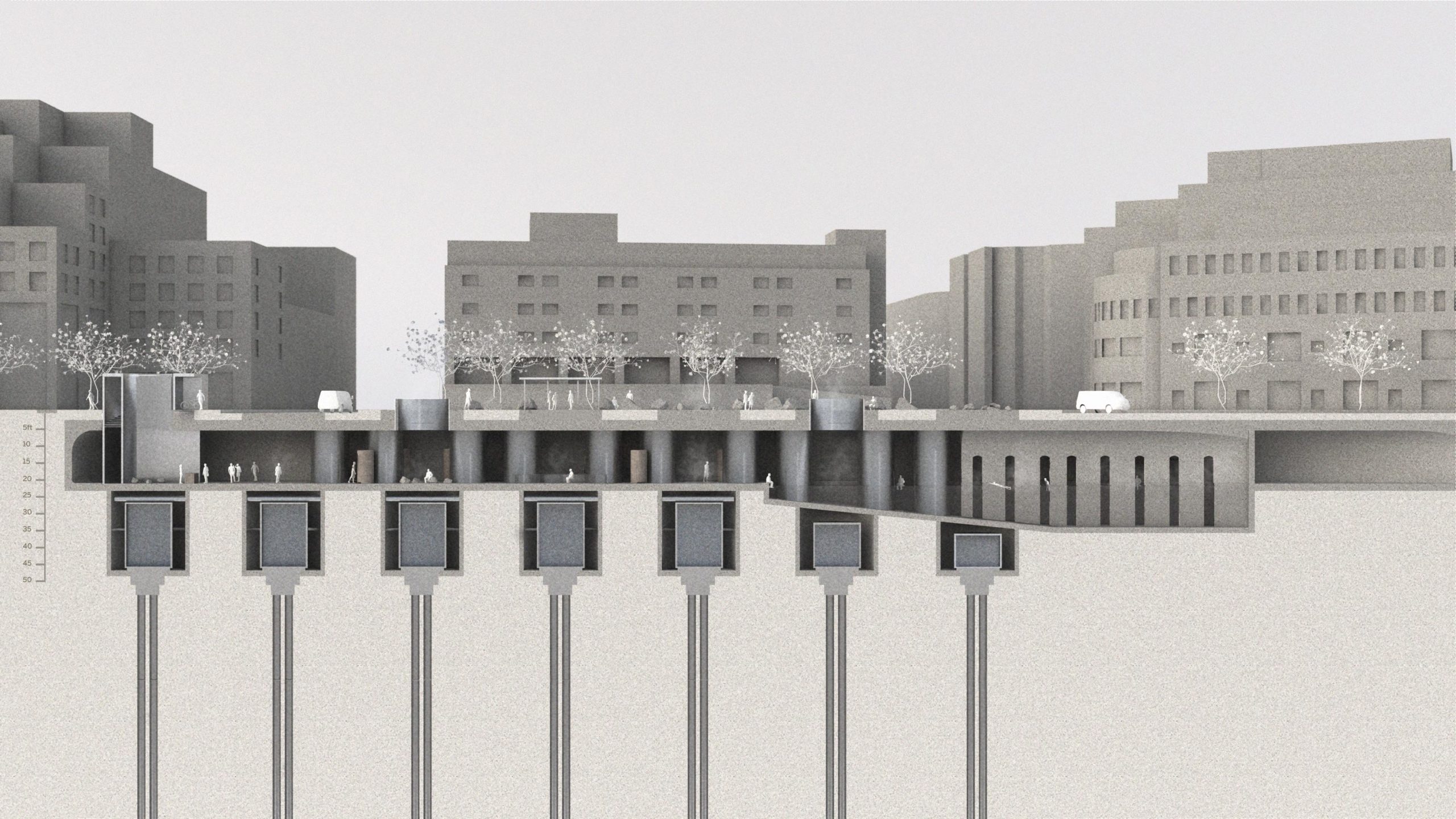
Section by Edda Steingrimsdottir (MArch ’22), “Below and Beyond” studio.
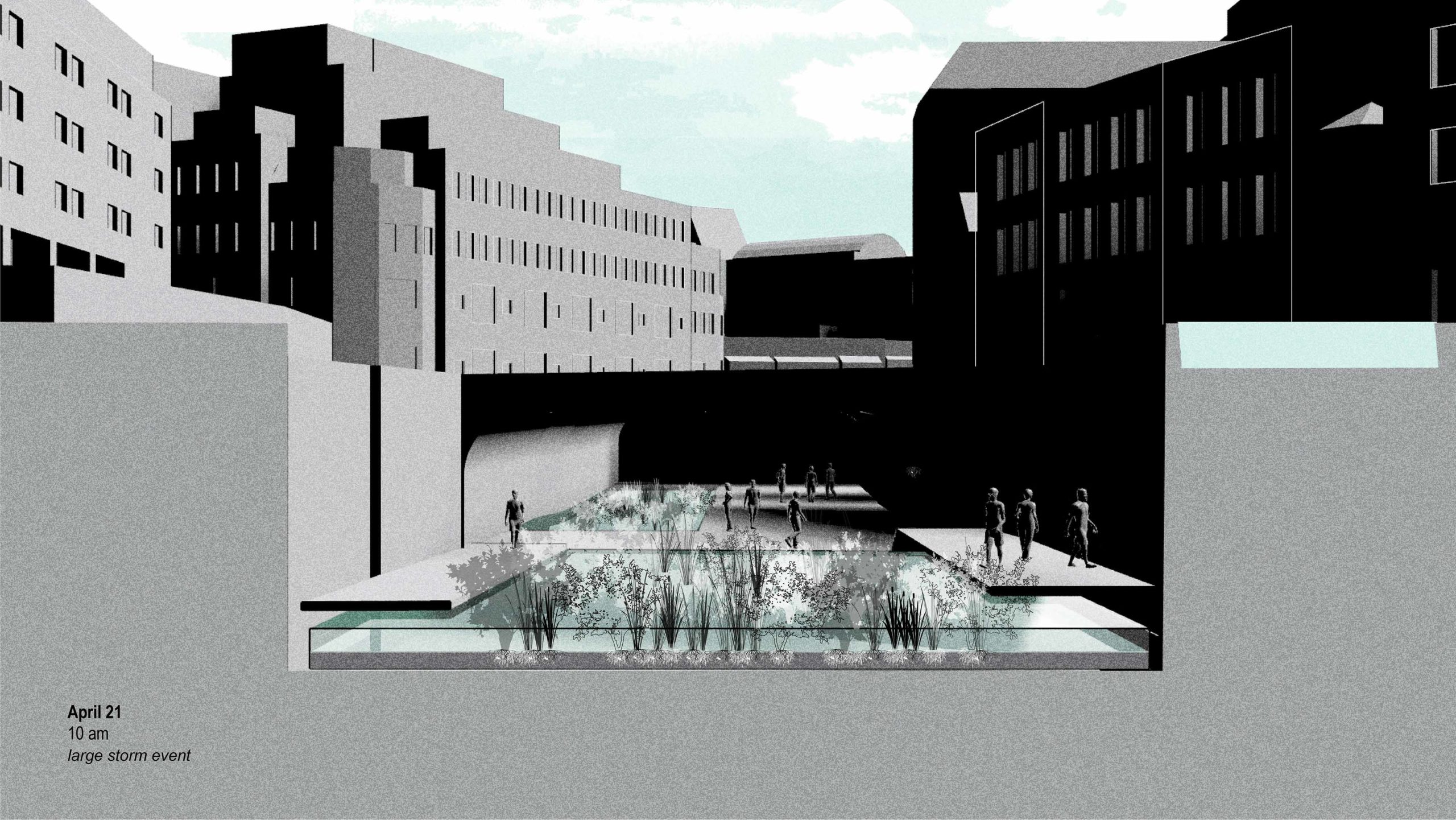
Section by Annie Hayner (MLA ’21), “Below and Beyond” studio.
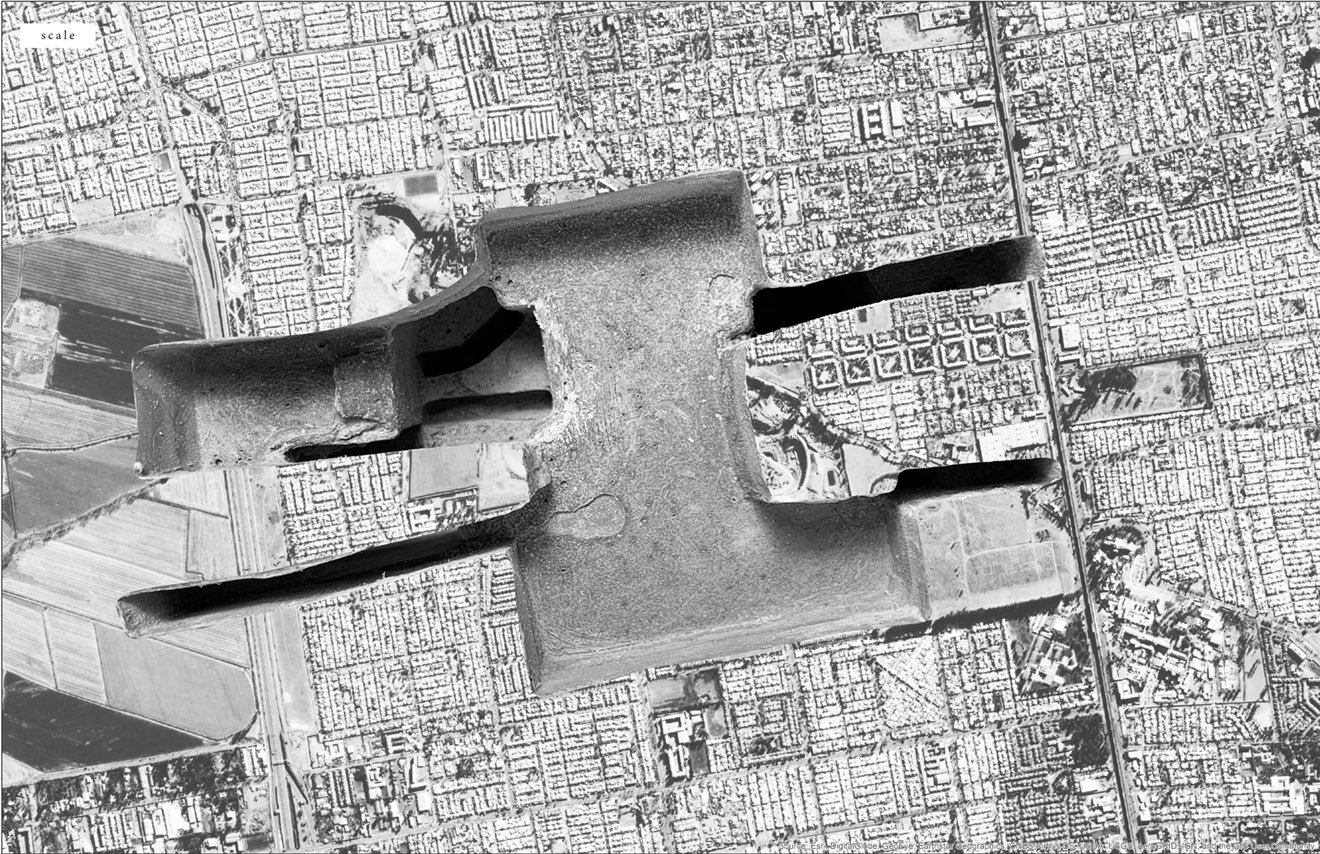
Collage by Michele Chen (MLA I AP ’21)
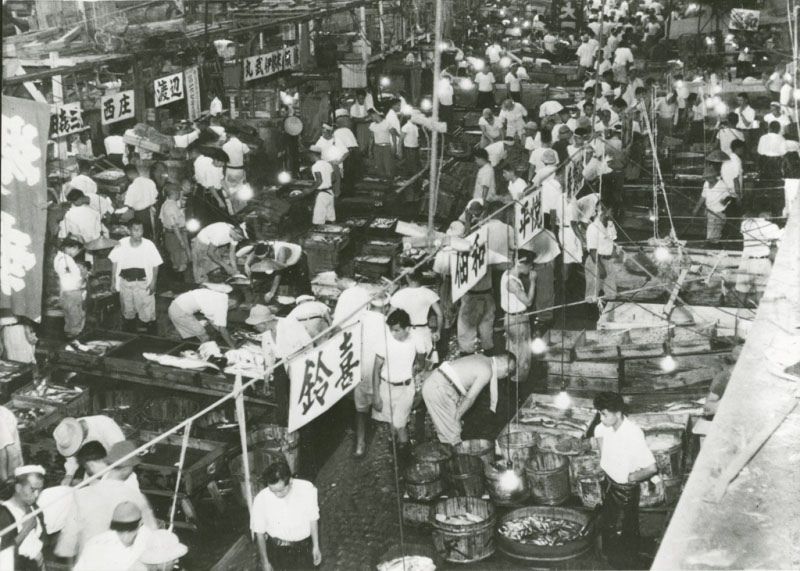
Tsukiji Fish Market sometime between 1955-1964. Image courtesy of Tokyo Metropolitan Government.
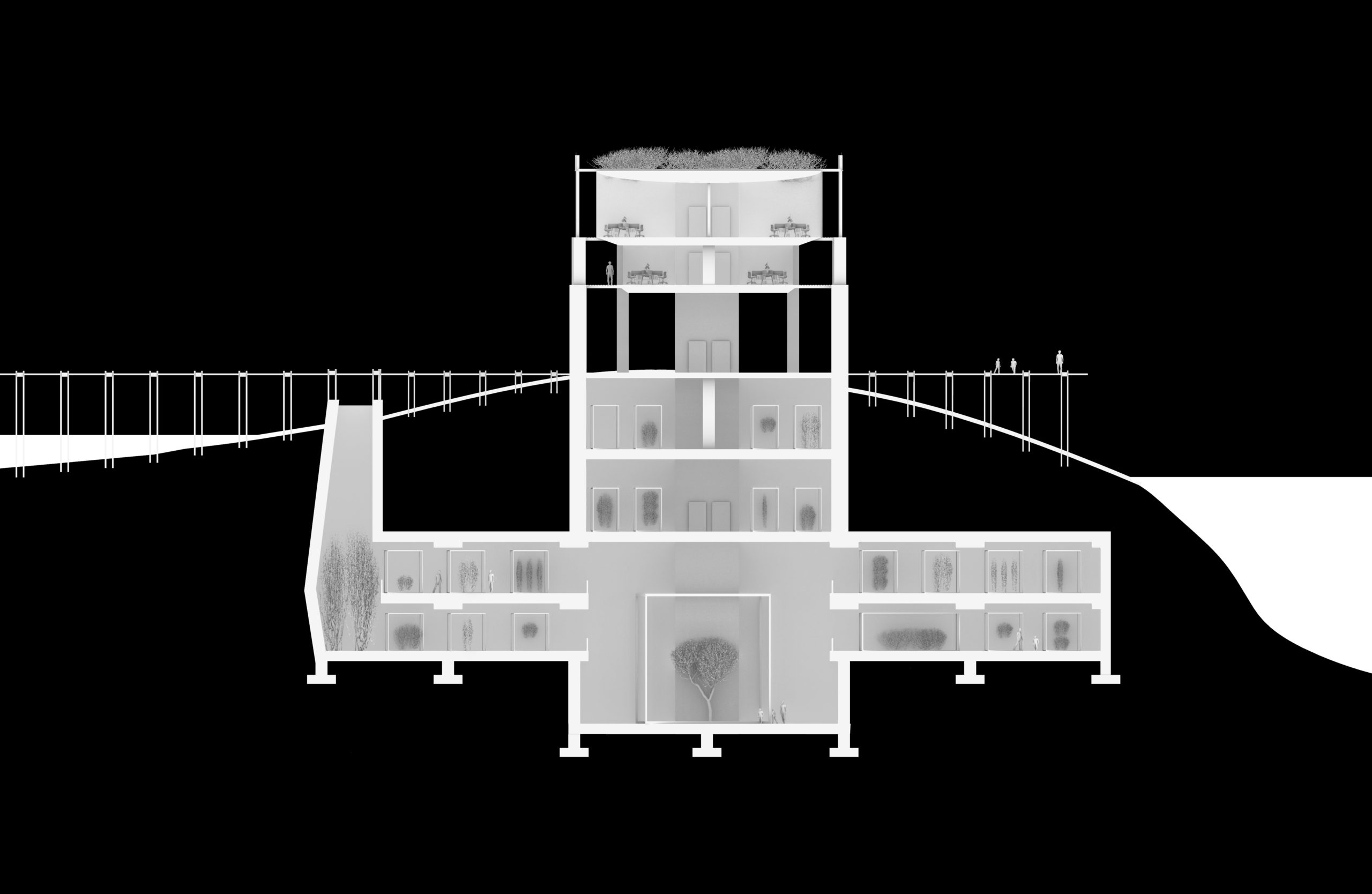
Section by Marie Stargala (March ’22), “Fudo/Umwelt” studio
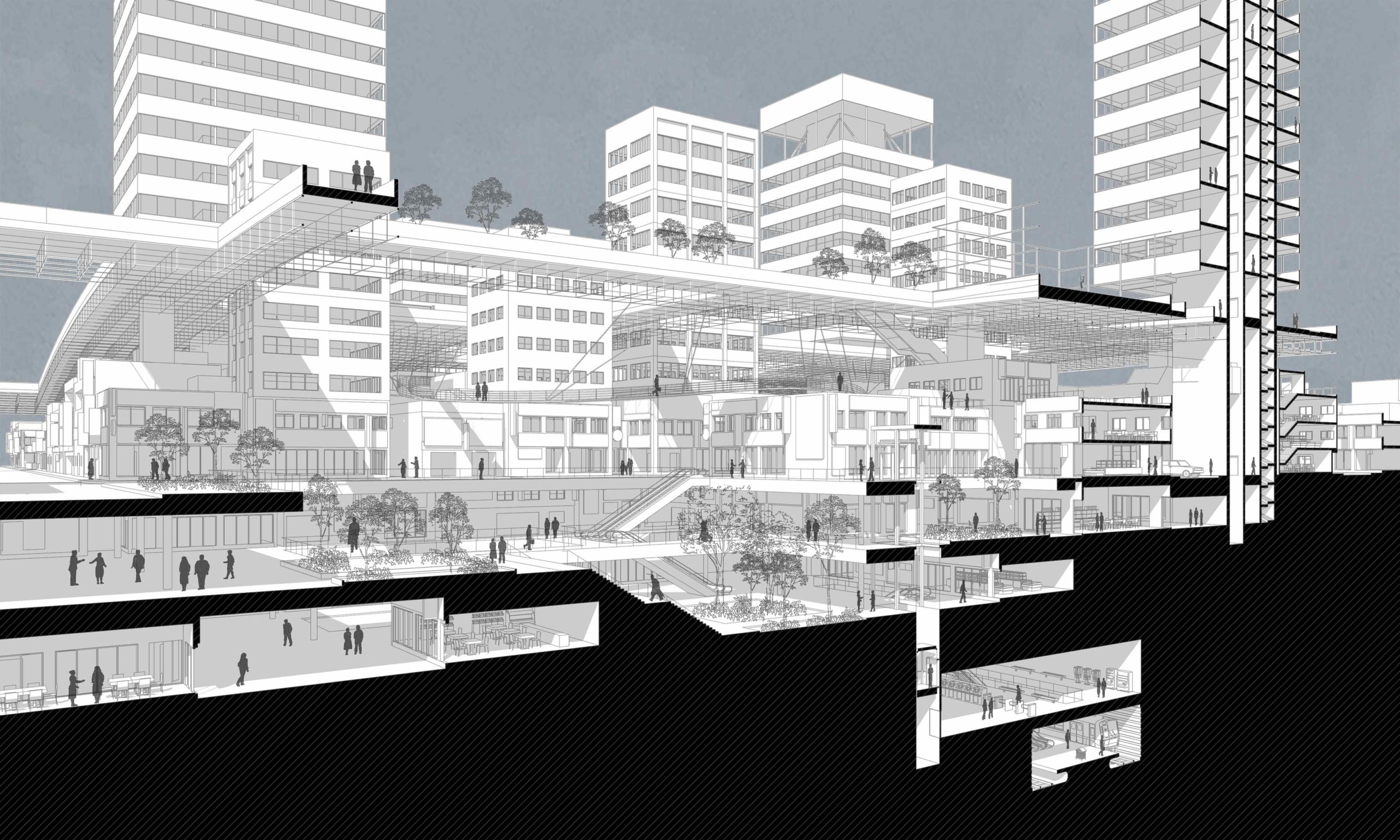
Section by Saul Kim (March II ’21), “Fudo/Umwelt” studio.
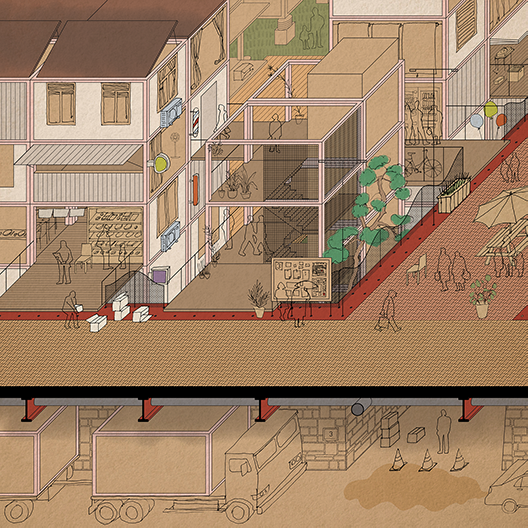
Image by Isabel Chun (March I ’22)
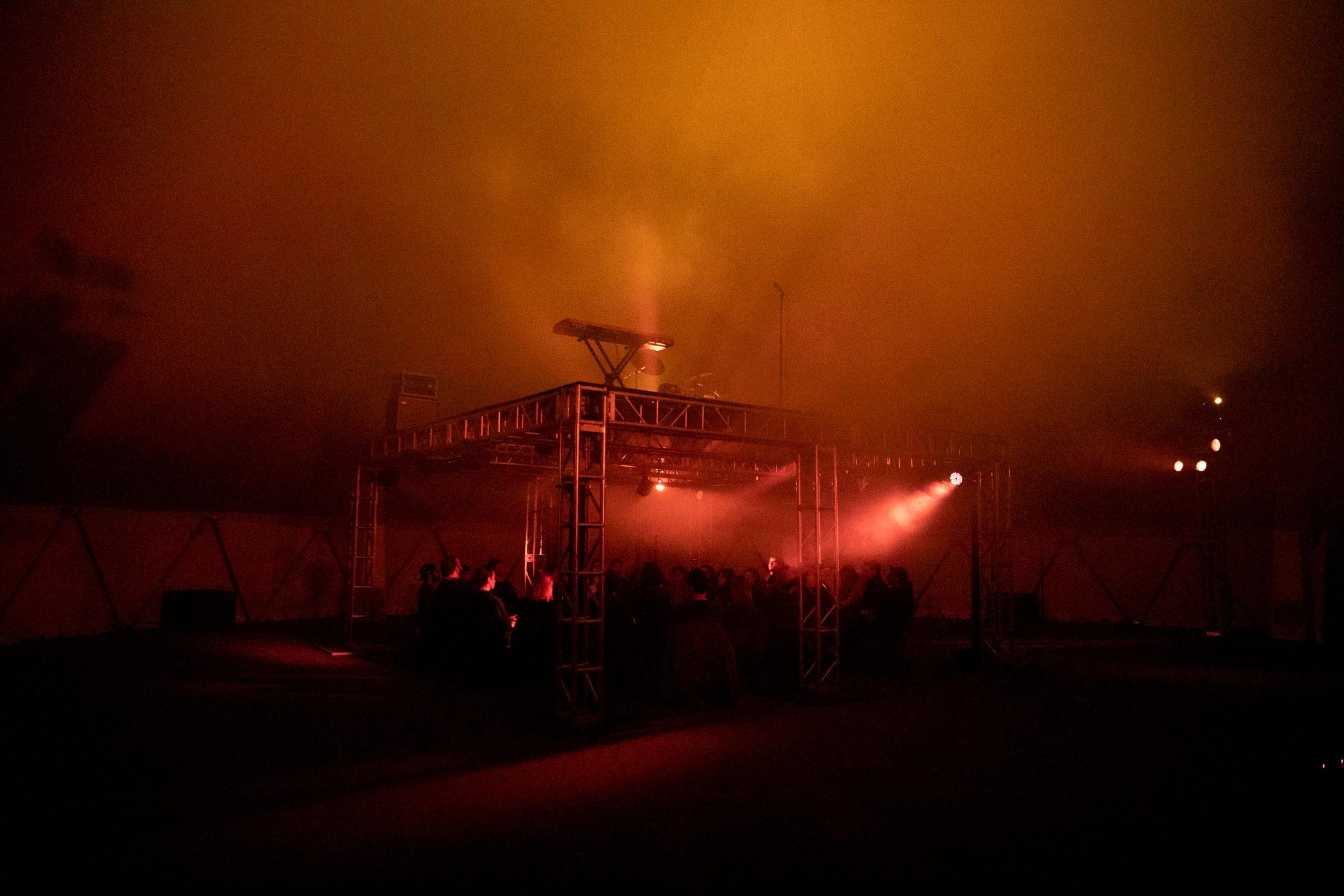
“Audiencing” by Nikita Gale, presented as part of the VW Sunday Session at MoMA PS1. Image courtesy of MoMA PS1. Photo by Maria Baranova.


Images by Kyat Chin, “Underground” studio.
The Black New Deal: Bryan C. Lee on challenging the power structures that use architecture and design as tools of oppression
When asked about the theoretical touchstones for his new studio, “The Black New Deal,” Design Critic Bryan C. Lee references almost exclusively the work of Black liberation thinkers and activists: Booker T. Washington, W.E.B. Du Bois, Black abolitionists, and leaders of the Black Panther Party and the Black Lives Matter Movement. Each understood the importance of space, place, and community-building in determining the overall condition of Black people in America. Lee is a practitioner of Design Justice, a movement to eradicate structural inequalities in design to create spaces of racial, social, and cultural equality. Its members include a growing cohort of architects, urbanists, and planners who are also deeply engaged in social justice discourse. They are as concerned with the societal impact of a designed product as with how it came into being. Traditionally marginalized communities are not just consulted—they lead the creative process in a collaborative exchange with designers.Who holds power in a particular condition? What is the injustice that results from that power? Who is directly and disproportionately impacted by that injustice? How does it physically manifest in the built environment? And where are the opportunities to challenge those systems and envision new ones that actually serve those who have been impacted by those injustices?
On the five questions that guide his pedagogical approach
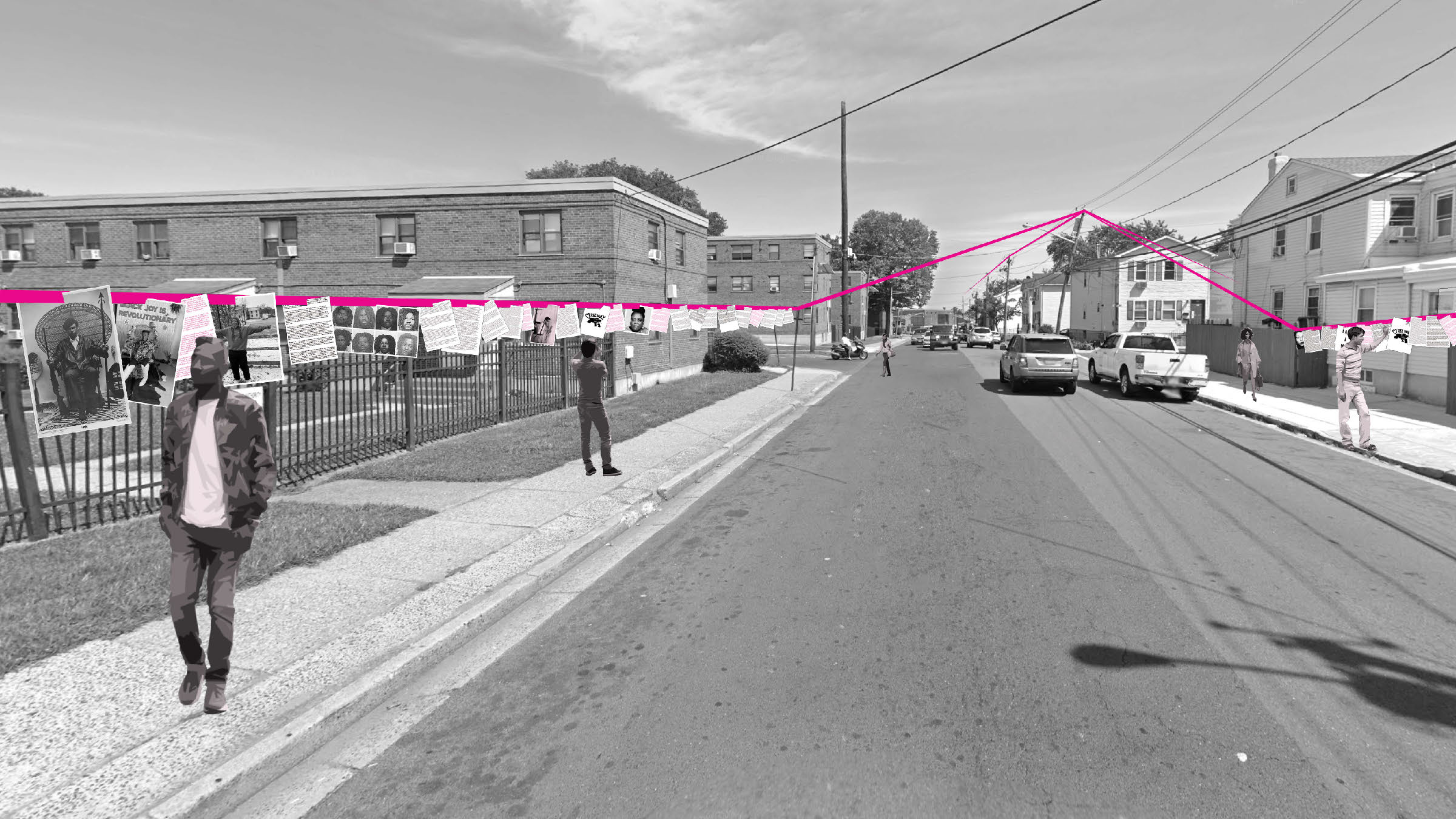
Image by Selwyn Bachus (MArch II ’22) for “The Black New Deal” studio, spring 2021
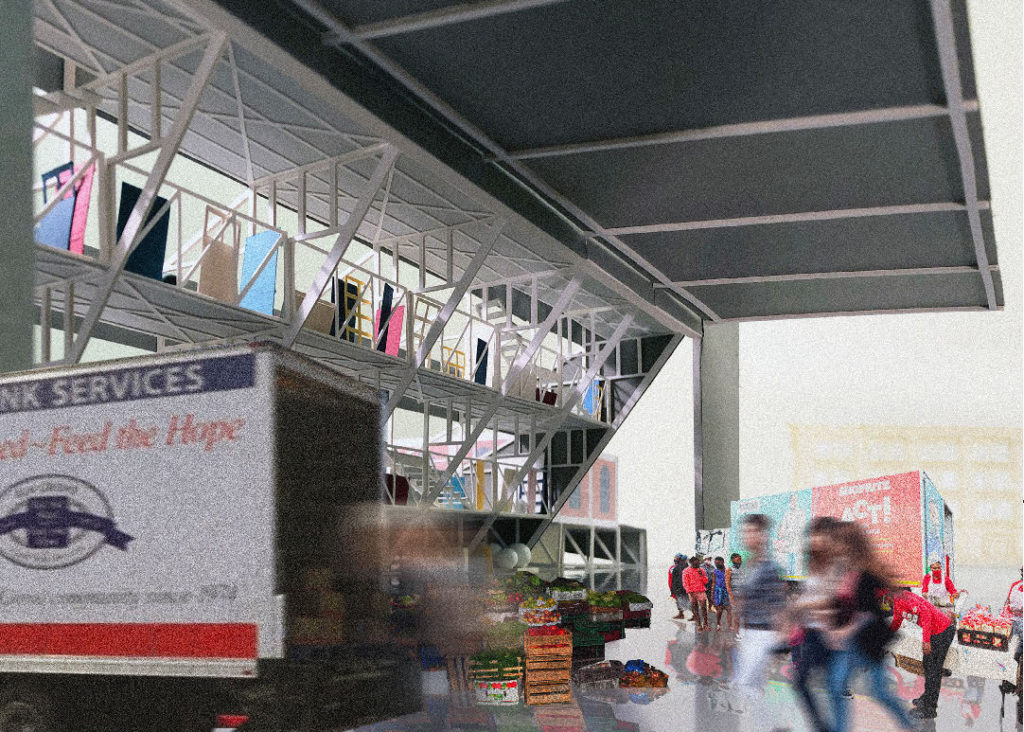
Image by Edward Wang (MArch AP ’22) for “The Black New Deal” studio, spring 2021
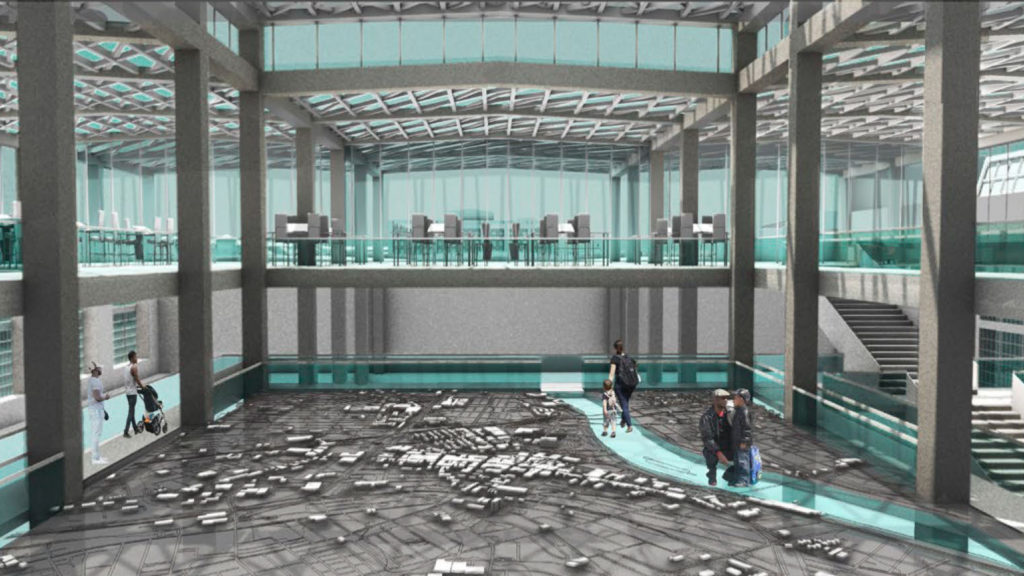
Image by Tyler Rodgers (MArch ’22) for “The Black New Deal” studio, spring 2021
Shading Sunset: Charles Waldheim on reimagining the streets of Los Angeles for a warmer future
In 1965, Ed Ruscha stood on the bed of a moving pickup truck and photographed Sunset Boulevard. Through this process he calls “motorized photography,” he captured the entirety of a mile-and-a-half long segment of the street with mechanized precision. These images were then collaged for Every Building on the Sunset Strip (1966), a book whose accordion-folded pages unfurl over 27 feet. The experience was not a one-off. Ruscha would soon traverse different thoroughfares in Los Angeles, including Wilshire and Sepulveda Boulevards, and perform the same operation. Every few years, he—and now others in place of the 83-year-old pop artist—returned to these streets to photograph them again and again. The cumulative result of the ongoing endeavor, which could be classified as a long-duration artwork as much as data collection, is an archive of over one million images. The Getty Institute recently acquired this unique history of Los Angeles’s built environment in pictorial form and, to date, has digitized over 60,000 photographs. Their goal is to make it both accessible to the public and, as Charles Waldheim’s spring studio, “Shading Sunset: Reimagining the Streets of Los Angeles for a Warmer Future,” exemplifies, useful as a tool for imagining alternative futures of the city.
Ruscha, Edward, Every Building on the Sunset Strip (1966). Artist’s book. Courtesy Joseph C. Sloane Art Library.
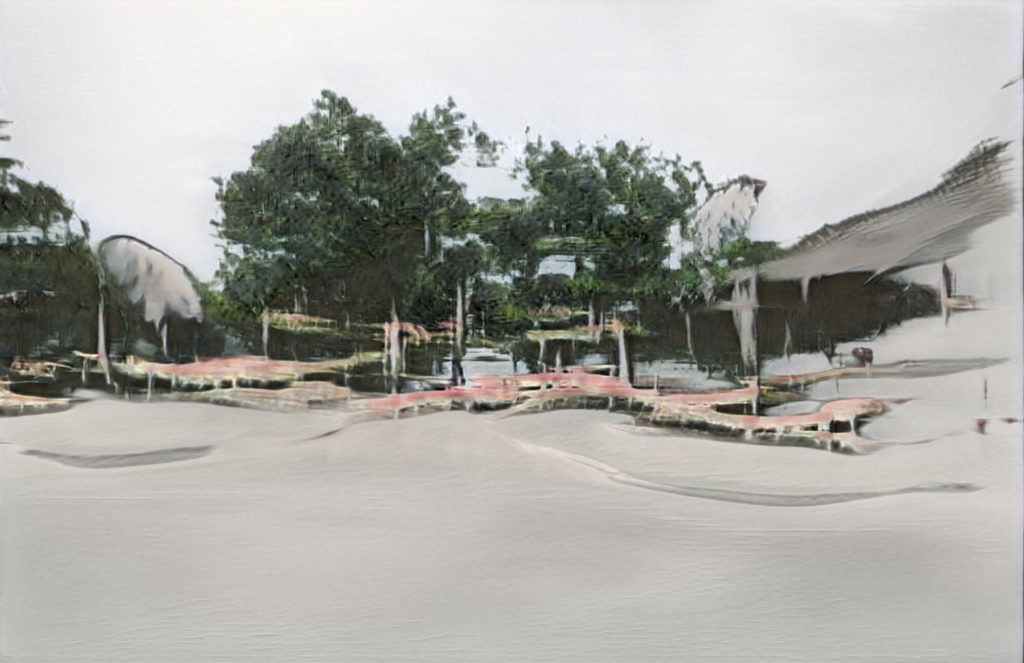
Michele Turrini (MLA ’21), Wave in Curbs (2021).
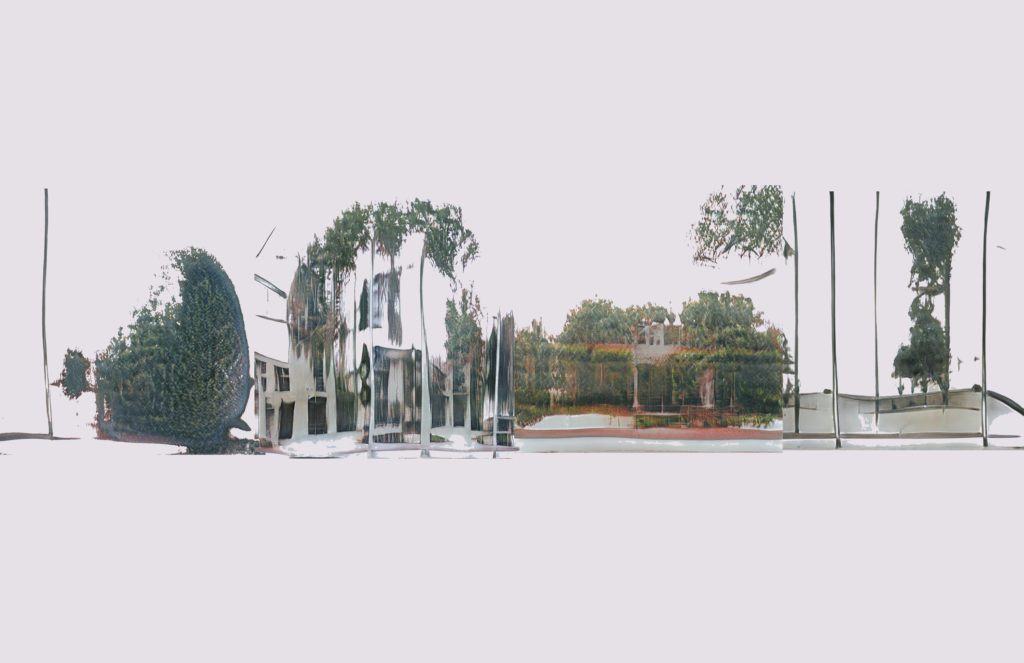
Austin Lu (MLA ’22), A Glimpse of a Pleasure Garden (2021).
Students in Dialogue: A conversation with MDE candidate Nupur Gurjar

Nupur Gurjar. Portrait by Chidy Wayne.
What drew you to the GSD and the Master of Design Engineering program?
After finishing my architecture undergrad degree, I stepped into design roles that were a bit unconventional, but ones that enabled me to explore critical design thinking. The Master of Design Engineering program is about applying design thinking into various fields, not necessarily just for architecture or the built environment but for design in a broad sense. The approach applies systems of thinking across cultural experience, collaboration with teams, learning by doing. The students in my cohort are not all from a design background; in fact, their backgrounds range from engineering to economics. Here, design means problem-solving and using critical thinking, innovative ideas, and principles of design to apply the right kind of approach to a project. Within MDE, I can bring in skills that are creative, critical, analytical, technical, and non-technical, and this gives me the freedom and flexibility to wear different hats and enter career paths as a designer who has the ability to understand problems and people.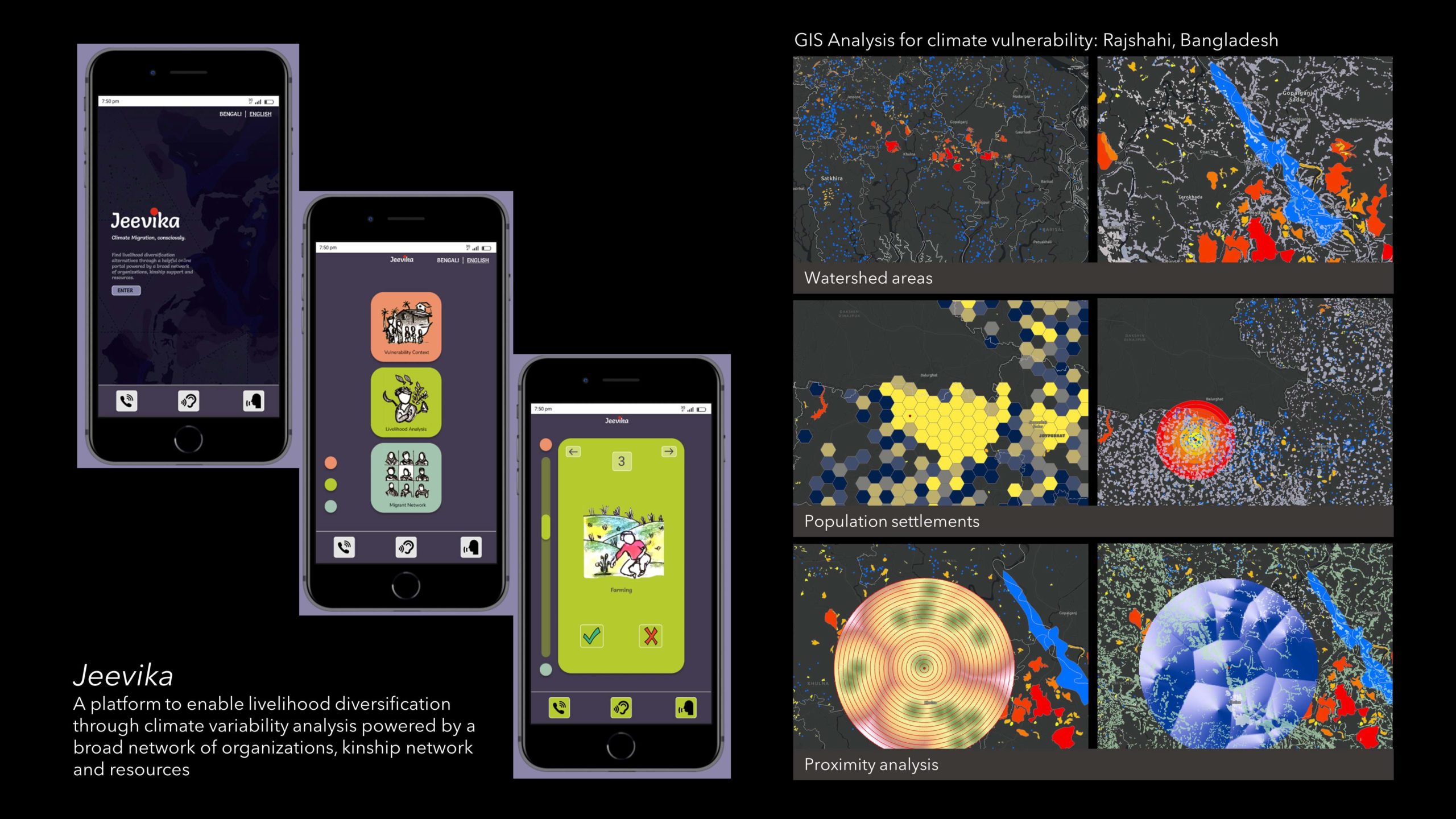
Images by Nupur Gurjar. MDE Independent Design Engineering Project. A systemic perspective to Climate Migration in Bangladesh: Visual Interaction Design
I really like what you’re saying about this multi-dimensional view on both what design is, but also your role as a designer. What was your experience before entering the program?
I’m from Bangalore, India, and in my final year studying architecture, I decided to intern in Mumbai. That internship really gave me a deeper idea of my passion, likes, and dislikes. At that point, large-scale commercial architecture jobs stopped holding their appeal to me, so I started exploring. I am also a performer and have been trained in classical dance and music. I entered the field of production design as a set designer for the media industry. I saw my training as a designer and a performer come together. Being a set designer was like looking at design and interiors through the lens of a camera that stretched beyond my drawings and 3D visualizations. I worked on a music video for Puma which was really colorful and cultural and for a web series with Amazon Prime. My second year of work experience was as a design research assistant in the city of Ahmedabad at CEPT University, Design Innovation and Craft Research Institute. I was part of a number of ethnographic field studies on vernacular furniture in northwest India. That opened doors to my interests in design research and engaging in a methodology to understand the influence of furniture design that has seamlessly integrated into the traditions, space, and life in communities.You really took an opportunity to explore your path as a designer whether it was through architecture, set design, or research. Was a portfolio required for the MDE program?
Yes: Design Engineering accepts candidates from all different backgrounds, so the content of portfolios ranges. Some students have architecture projects, and others might emphasize research/ policy studies/ economics/ science and technology, etc. in their portfolio. The MDE program is very broad, and I tried to connect my diverse set of experiences and understanding of design to the vision of this program. When submitting your portfolio, I would recommend that you show your process of learning, discovering, and thinking that led to certain decisions; include low-fidelity prototypes, sketches, and mock-ups for products/ services or experiences designed. This could depend on the kind of project being showcased, but ultimately, it is important to include why a certain intervention matters and what value or impact it has on society.Within MDE, I can bring in skills that are creative, critical, analytical, technical, and non-technical, and this gives me the freedom and flexibility to wear different hats and enter career paths as a designer who has the ability to understand problems and people.
Was there a specific subject that you wanted to study when entering the GSD?
I looked forward to studying at the GSD, and to be frank, I did not have a specific focus at first. It was my first time traveling internationally, and I was looking forward to absorbing a new outlook on my student life experience. I remember my admiration while walking the halls of the GSD with professionals that I’d read about in publications. That was truly exciting for me. I wanted to immerse myself in experiences that would help me grow as a designer, within the conventional boundaries of where designers thrive but also beyond it, at the intersection of other emerging fields and technologies.How is the MDE program structured, and what projects excited you?
The MDE program is semi-structured with some mandatory courses but also a considerable amount of flexibility. We have Design studios in our first year with exposure to a system of working in cross-functional teams on quick design sprints as well as longer projects on Product, Service, Experience design with a hint of Data visualization and UI/UX design based on project demands along different themes that is set for every MDE incoming cohort. The first year can be exhausting, but it paves the way for our year-long Independent Design Engineering Project (IDEP) in the second year. I am working on designing an experiential service design intervention on climate migration in Bangladesh for vulnerable communities impacted by gradual climate events.Have you taken any courses outside of the GSD?
Last semester I took “Conducting Negotiation on the Frontlines” at the Kennedy School of Government. It taught me about negotiation in a relational environment. It was an amazing course, and I think I was the only design school student. The experiential course design enabled the intersection of design thinking in humanitarian response. I met a lot of new people and made a lot of new friends. Another course I cherished was at Harvard Law School, a place where I had never imagined design to be applicable. My interest in climate design led me into a project where we were looking at reducing artificial synthetic nitrogen fertilizers for farmers, and we were even able to visit Wisconsin for our research. I enjoyed the challenge of addressing a complex challenge for the farmers to enhance or maintain their yield while reducing the fertilizer application through a tool kit designed for fertilizer calculations and modeling.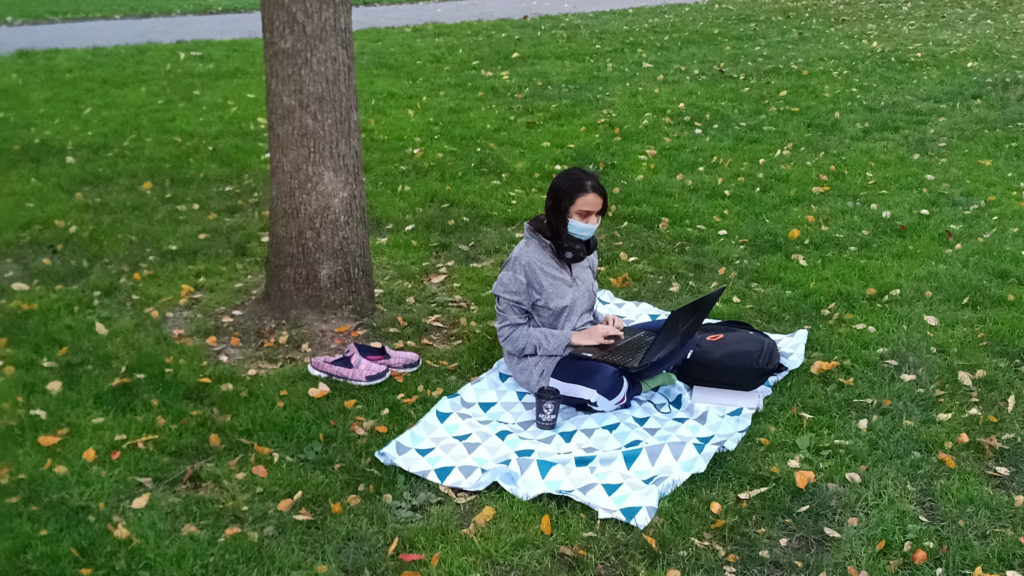
Nupur studying outside in the fall of 2020.

